|
|
Post by codystarbuck on Feb 18, 2020 13:09:17 GMT -5
All-Star Squadron #12 Carter Hall, starring in the Hawk-back of Notre Dame. Creative Talent: Roy Thomas-writer, Adrian Gonzales-pencils, Jerry Ordway-inks, John Costanza-letters, Carl Garrod-colors, Len Wein-editor Synopsis: January, 1942..... Wait, we are 12 issues in (12 1/2, if you count the preview) and we've only progressed a month, month and a half? Gonna be a loooooong war! The All-Stars leave Napier's estate and Hawkman recounts his origin, including being a reincarnated pharaoh (why are they never reincarnated sheepherders or farmers?), where as Prince Khufu, he and lady love Chay-Ara are murdered by Hath-Set, cursed to be reborn in the modern world as Carter Hall, archeologist and Shiera Sanders. He has dreams of being Khufu and runs into Shiera, who has similar dreams, is compelled to put on a hawk mask, some wings he made, and a belt of Ninth Metal and flies... 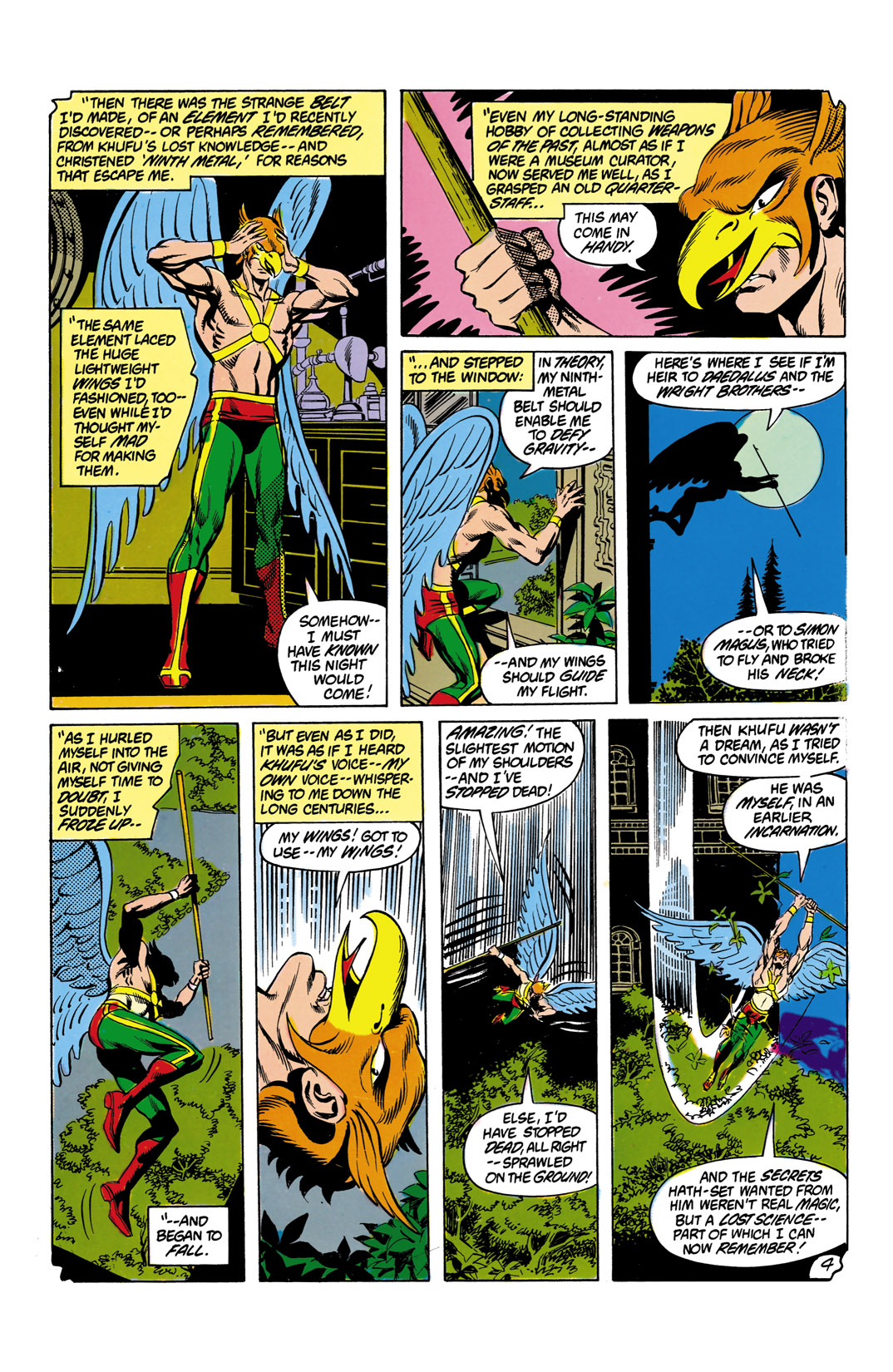 Shiera is kidnapped by one Dr Hastor, who is Hath-Set reborn. They fight, Hawkman kills him, or so he thought. Meanwhile Atom tries to attack Hastor and is stopped by a mental bolt, Hastor's powers augmented by a bunch of scientists in glass tubes.  Then, Hastor monologues about what happened after he was shot by a crossbow bolt. I just watched a bunch of DR Who reviews and this part reminds me of the Master, complete with van dyke beard! Hastor was a genius in electrical engineering and was approached by Napier to join his group. he spoke of a coming war, with lightning attacks and what not. Hastor, like many, believes it will be a repeat of WW1, with trench warfare stalemate and dirigibles dropping poison gas on cities. Napier's mathematical formulas are used to predict the future. Hastor sees things play out as Napier predicted. 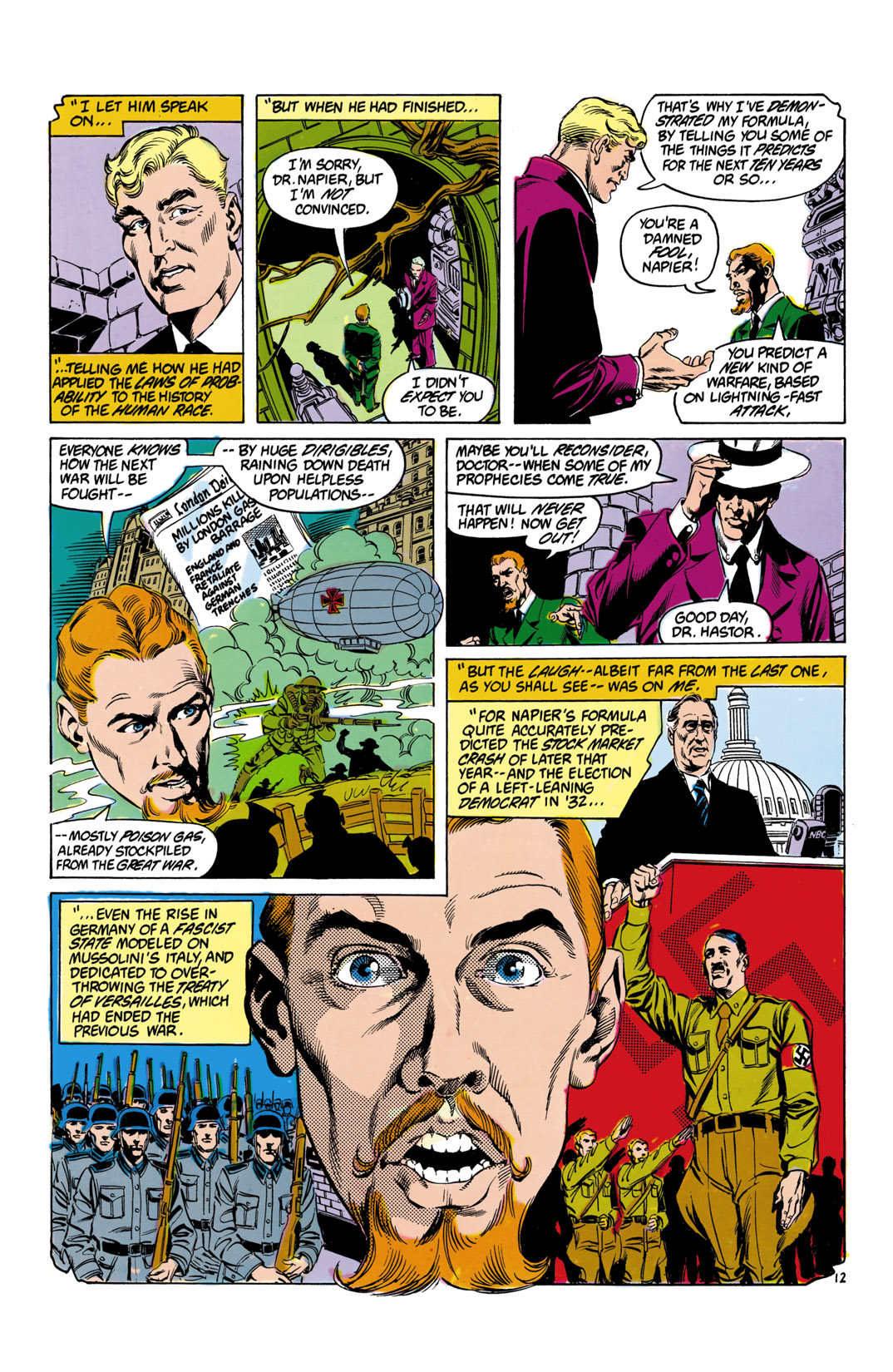 After the battle with Hawkman, Hastor survives, through sheer will (and mental power, of some sort). he seeks out Napier and his group and finds their hidden base, where they are building the eye ship to "bring peace to a troubled world." It is to be powered by glass tubes which tap the mental power of the scientists. So, of course, Hastor sabotages things and takes control and concocts his hoax. The eye turns up at the base where FDR and Churchill are hold up (how did Hastor know where they were?) The ship attacks, but the All-Stars drop on it, from above, via hot air balloon...  Hastor dumps them inside, Hawkman grabs the dagger and his astral form takes on Hastor's.  Hastor gets whooped, the ship loses power and plummets. Libby wakes up Robotman, whose brain takes control and lands the ship. They all disembark and turn Hastor over to the Army. Thoughts: Well, Roy's been reading his HG Welles! This is a combination War of the Worlds, War in the Air and The Shape of Things to Come, with a bit from The Mummy and Flash Gordon (Hawkman's origin). A lot of the issue is an exposition dump, covering the Hawks and Hastor, Hastor and the scientists, and the ship's power. So, the finale is a bit abrupt and is a bit less than energetic, as it is resolved by two guys standing there, as ghosts snarl at each other. Overall, the story is pretty good and memorable, but, the ending is a bit too metaphorical. This is one of the major differences between Roy's approach on All-Star Squadron and Invaders. All-Star ends up being more about principles and ideologies, with mysteries and metaphors, while Invaders was about punching Super Nazis. Roy kind of got to this area, as Invaders moved past Master Man and Warrior Woman; but, he goes even further in this territory, here. Not saying it's bad; just different. My only real quibble with this is the resolution is a bit of a letdown, after the build up. It's the problem of using a mental character in a visual medium. how do you show a mental fight? Well, the astral form thing was a Marvel staple and others took it up. However, this was all of three panels. the Hawks combined astral power beats Hastor, while everyone one else reacts and they cut to the ship continuing its attack on the soldiers below. I just think Roy could have trimmed the exposition (especially Hawkman's origin) and expanded the finale. Roy also needs to throw a nod to Archie Goodwin. In the seminal Manhunter back-up series, the Council turned out to be one guy, who had the other scientists under his control, in glass tubes, which fed him mental power that he uses to blast Manhunter. Now, they both might have borrowed it from some sci-fi story I have never read or heard of, or pulp novel plot. Good storyline, little weak on the finish. Historical Notes: Khufu was an actual pharaoh, from the Fourth Dynasty, known to the Greeks as Cheops, buried in the Great Pyramids of Giza. Little concrete is known of him, as ancient historical writings are conflicting. Because of the pyramids, he was a favorite of writers and Hollywood, not to mention comic books. HG Welles needs no introduction, except maybe to Generation Z kids who only read internet postings. One of the founding fathers of what became known as science fiction, he was also a social crusader and critic. Much of that informs his fictional work, especially the sci-fi. Three of his works factor in this story. War of the Worlds was written in 1897, first serialized and, then, as a novel, which features a Martian invasion of the Earth, as seen in Great Britain. The Earthmen are powerless to stop the Martian war machines, though there are moments of hope and valor. Ultimately, they fall to terran bacteria, as they have no immunity. It would inspire several films; but, it is a radio show that concerns us here. In 1938, the Mercury Theater of the Air, starring Orson Wells, ran a broadcast that adapted the story. The adaptation was written by Howard Koch, who transported it to the US and added news reports and other features. The original script was considered a bit dull and a late doctoring session, with Koch, John Houseman, and typist Anne Froelick. they re-worked the script, added things like breaking news interrupting music programs and created a masterpiece. The broadcast did have an opening that emphasized that it was a radio drama, as the program was presented as a nightly music broadcast that is interrupted. It would be 20 minutes before another narration would stress it was a drama. However, some folks missed that part or didn't pay attention and thought it was a real news bulletin and went a bit nuts. Now, there are all kinds of theories and reports and many exaggerate certain elements and events, to make the story better. Some theories have been debunked by facts, others seem a stretch. Much of the hysteria was in the papers, which were trying to sell copies, though police stations were getting frantic calls. Authorities contacted CBS and ordered an interruption of the program, though the call came just minutes before the planned interruption, so they went with it as is. Police turned up at the studio, but did not stop the broadcast, though they did harangue execs. the cast avoided reporters by slipping out a back alley door. The War in the Air featured Welles' predictions, based on the fighting of WW1, with nations with vast fleets of airships bombing cities from the air, as German zeppelin attacks had created vast hysteria during the war, though little actual damage (especially compared to the Blitz). German airships launch a surprise attack on the US. The Shape of Things To Come furthers these themes, while adding a group of aviators and transport leaders creating a benevolent dictatorship, based out of Basra, Iraq (with its extensive oil fiields). That novel was adapted, by Welles, for the 1936 film, Things to Come, directed by William Cameron menzies, starring Raymond Massey and Ralph Richardson. In the film version, war breaks out in Europe and becomes protracted, with extensive bombing of cities and use of poison gas. Warlords arise, including The Boss (Richardson) who is trying to use old technology to attack the Hill People. An aviator, John Cabal, in a high tech plane, shows up and is captured. He is forced to help rebuild old planes. However, he gets a message off to his colleagues, Wings Over the World, who send their giant bombers to drop sleep gas bombs on the Boss and his troops, ending the fighting. they take control and soon build an underground civilization and utopia, which years beyond are about to launch a vessel to the moon, which has created great controversy. the film was noted for its imaginative sets, created by Vincent Korda, brother of producer Alexander Korda. The art deco bombers, which appear massive, are a personal favorite of mine... 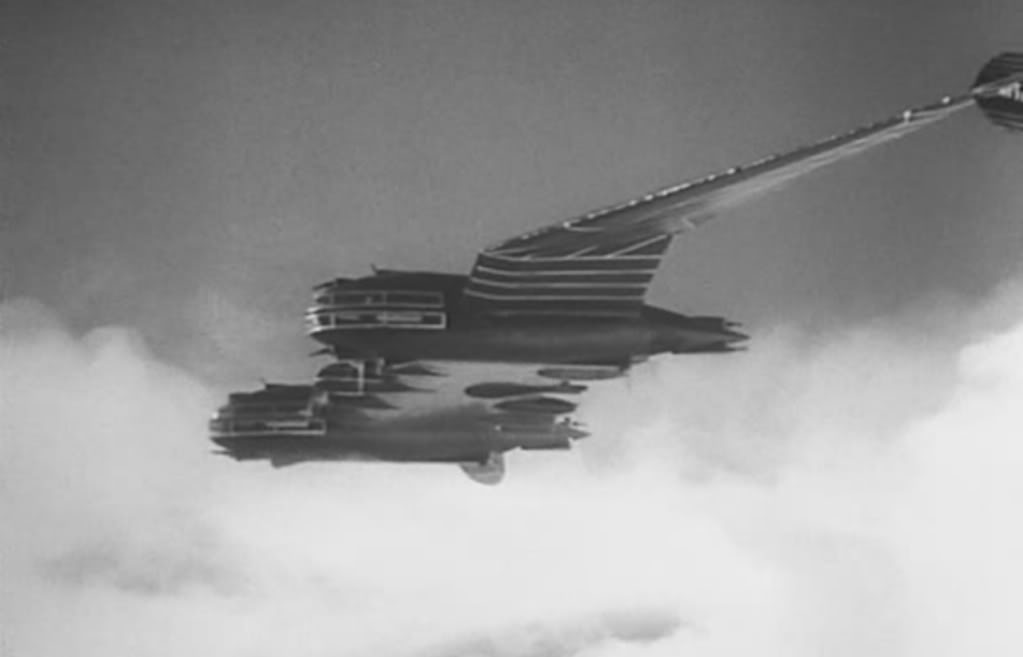  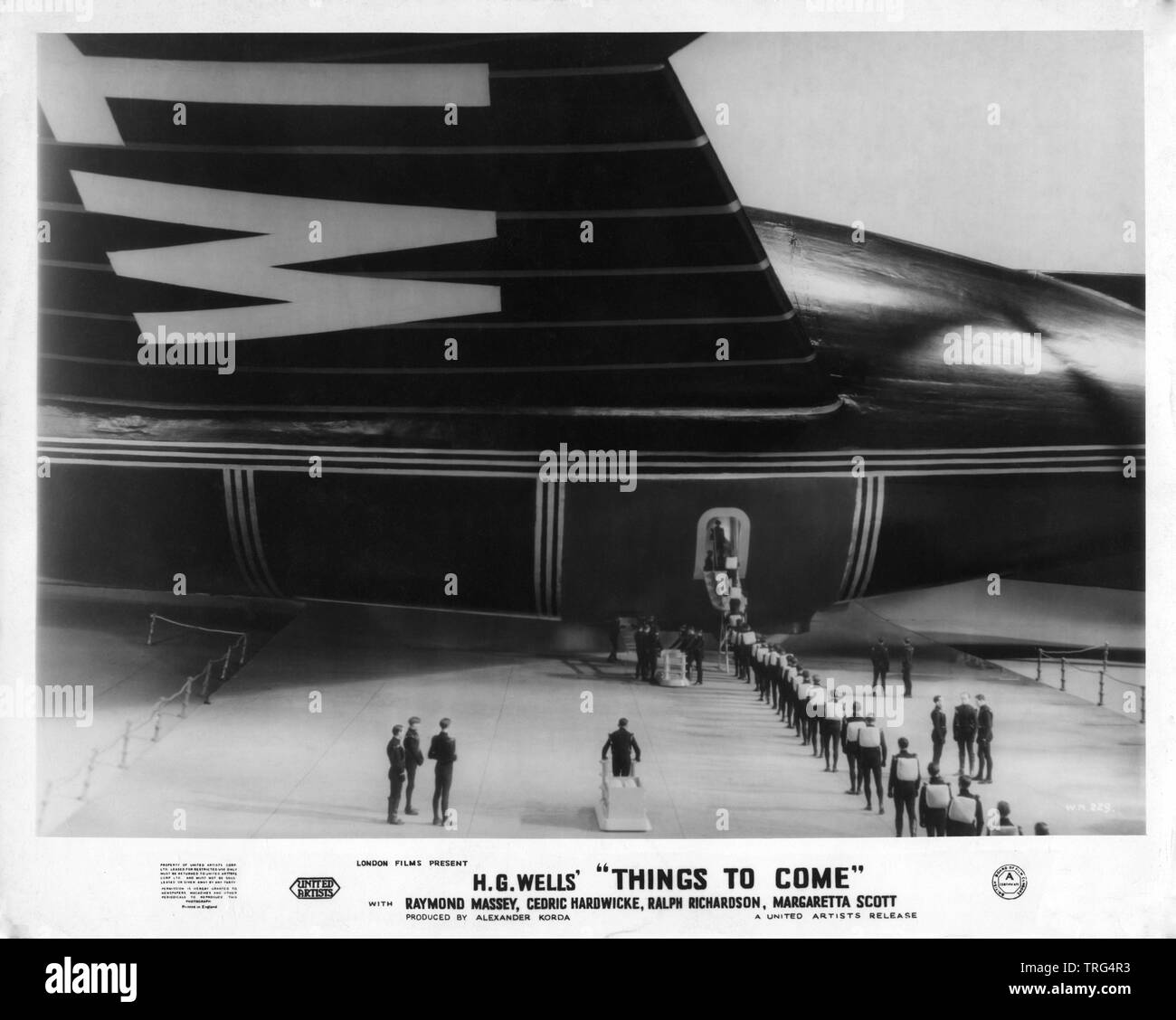
|
|
|
|
Post by zaku on Feb 18, 2020 13:16:02 GMT -5
Is it my impression or the stories so far would have remained practically unchanged in the post-Crisis continuity with very few tweaks? Why do people say that Crisis "destroyed" Roy Thomas' All-Star Squadron.
|
|
|
|
Post by codystarbuck on Feb 18, 2020 15:57:24 GMT -5
Is it my impression or the stories so far would have remained practically unchanged in the post-Crisis continuity with very few tweaks? Why do people say that Crisis "destroyed" Roy Thomas' All-Star Squadron. Because it pretty much caused the series to grind to a halt, as the change in things eliminated some characters, significantly changed the histories of others and undermined his momentum. He basically ended the series with a few origin stories, then retweaked things as Young All Stars. the problem is, the main thrust became the creation of replacement heroes to fulfill the Golden Age roles of the Triumvirate, with iron Munro replacing Superman (the son of Hugo Danner, from Gladiator, an inspiration for Superman) and Fury replacing Wonder Woman (mainly to provide a mother to the modern Fury, in infinity, Inc, which was still ongoing). There were also editorial mandates that undercut Roy's plans and an outright desire by a faction to get rid of the JSA as relics of the past, leading to the Last JSA Story. It soured Roy on DC, among other things. The JSA mandate didn't last too long, so the same faction tried killing off the JSA members and aging others, to be replaced by new versions. That didn't go over that well, either, though more of it stuck than outright removing the entire gang. Now, by that point, sales weren't exactly setting the world on fire; so Crisis wasn't the main thing killing the series; but it seriously hampered it. |
|
|
|
Post by Prince Hal on Feb 18, 2020 16:15:38 GMT -5
Is it my impression or the stories so far would have remained practically unchanged in the post-Crisis continuity with very few tweaks? Why do people say that Crisis "destroyed" Roy Thomas' All-Star Squadron. There were also editorial mandates that undercut Roy's plans and an outright desire by a faction to get rid of the JSA as relics of the past, leading to the Last JSA Story. It soured Roy on DC, among other things. The JSA mandate didn't last too long, so the same faction tried killing off the JSA members and aging others, to be replaced by new versions. That didn't go over that well, either, though more of it stuck than outright removing the entire gang. Now, by that point, sales weren't exactly setting the world on fire; so Crisis wasn't the main thing killing the series; but it seriously hampered it. Me, too. |
|
|
|
Post by mikelmidnight on Feb 19, 2020 14:40:00 GMT -5
Because it pretty much caused the series to grind to a halt, as the change in things eliminated some characters, significantly changed the histories of others and undermined his momentum. He basically ended the series with a few origin stories, then retweaked things as Young All Stars. the problem is, the main thrust became the creation of replacement heroes to fulfill the Golden Age roles of the Triumvirate, with iron Munro replacing Superman (the son of Hugo Danner, from Gladiator, an inspiration for Superman) and Fury replacing Wonder Woman (mainly to provide a mother to the modern Fury, in infinity, Inc, which was still ongoing).
I didn't much care for any of the replacement characters, but I understand he'd tried to get the EC Comics character Moon Girl as a WW replacement, which would have been awesome.
|
|
|
|
Post by Slam_Bradley on Feb 19, 2020 14:47:27 GMT -5
Is it my impression or the stories so far would have remained practically unchanged in the post-Crisis continuity with very few tweaks? Why do people say that Crisis "destroyed" Roy Thomas' All-Star Squadron. Because it pretty much caused the series to grind to a halt, as the change in things eliminated some characters, significantly changed the histories of others and undermined his momentum. He basically ended the series with a few origin stories, then retweaked things as Young All Stars. the problem is, the main thrust became the creation of replacement heroes to fulfill the Golden Age roles of the Triumvirate, with iron Munro replacing Superman (the son of Hugo Danner, from Gladiator, an inspiration for Superman) and Fury replacing Wonder Woman (mainly to provide a mother to the modern Fury, in infinity, Inc, which was still ongoing). There were also editorial mandates that undercut Roy's plans and an outright desire by a faction to get rid of the JSA as relics of the past, leading to the Last JSA Story. It soured Roy on DC, among other things. The JSA mandate didn't last too long, so the same faction tried killing off the JSA members and aging others, to be replaced by new versions. That didn't go over that well, either, though more of it stuck than outright removing the entire gang. Now, by that point, sales weren't exactly setting the world on fire; so Crisis wasn't the main thing killing the series; but it seriously hampered it. While Roy could have continued even if Crisis hadn't happened I seem to recall that sales on A-SS were softening and I suspect it would not have been long for the world anyway. Young All-Stars was mostly a disaster in about every way it could have been. The only marginally interesting thing about it (and this is based on vague memories since I've not read it in at least 25 years) was that Roy started hitting some fairly Wold-Newtonian notes with it. |
|
|
|
Post by codystarbuck on Feb 19, 2020 15:59:17 GMT -5
Because it pretty much caused the series to grind to a halt, as the change in things eliminated some characters, significantly changed the histories of others and undermined his momentum. He basically ended the series with a few origin stories, then retweaked things as Young All Stars. the problem is, the main thrust became the creation of replacement heroes to fulfill the Golden Age roles of the Triumvirate, with iron Munro replacing Superman (the son of Hugo Danner, from Gladiator, an inspiration for Superman) and Fury replacing Wonder Woman (mainly to provide a mother to the modern Fury, in infinity, Inc, which was still ongoing). There were also editorial mandates that undercut Roy's plans and an outright desire by a faction to get rid of the JSA as relics of the past, leading to the Last JSA Story. It soured Roy on DC, among other things. The JSA mandate didn't last too long, so the same faction tried killing off the JSA members and aging others, to be replaced by new versions. That didn't go over that well, either, though more of it stuck than outright removing the entire gang. Now, by that point, sales weren't exactly setting the world on fire; so Crisis wasn't the main thing killing the series; but it seriously hampered it. While Roy could have continued even if Crisis hadn't happened I seem to recall that sales on A-SS were softening and I suspect it would not have been long for the world anyway. Young All-Stars was mostly a disaster in about every way it could have been. The only marginally interesting thing about it (and this is based on vague memories since I've not read it in at least 25 years) was that Roy started hitting some fairly Wold-Newtonian notes with it. He did do a meeting of the Manhunters, which was one of the few decent elements of Millennium (along with Mark Shaw in the Suicide Squad and the swamp sequence, with the unified covers, across several titles). |
|
|
|
Post by mikelmidnight on Feb 20, 2020 12:46:56 GMT -5
He did do a meeting of the Manhunters, which was one of the few decent elements of Millennium (along with Mark Shaw in the Suicide Squad and the swamp sequence, with the unified covers, across several titles).
I mainly hated Millennium, although I acknowledged in this case the candidates for 'Who is a Manhunter spy' were nicely obvious and handled about as well as one could do.
|
|
|
|
Post by codystarbuck on Feb 22, 2020 22:11:19 GMT -5
All-Star Squadron #13 You ever try to run like Cdr Steel is doing? Kind of hard to keep your balance! Kubert is a little sketchy on the cover figures; but, you can't beat that layout, or the background detail, with actual images from the era, reminding us how dire things were in January, 1942. Creative Team: Roy Thomas-writer, Adrian Gonzales-pencils, Mike DeCarlo-inks, Ben Oda-letters, Carl Gafford-colors, Len Wein-editor Mike DeCarlo sitting in for Jerry Ordway. This kind of gives you an idea of just how much Ordway was contributing to the book. Synopsis: With everything relatively calmed down (there is a war on, you know?), Hawkman has called together a meeting of the All-Stars. There is much banter and Hawkman reminds us that not all of the JSAers went into the military, including Superman (he was 4F, thanks to his x-ray vision), Batman (draft dodging millionaire), Spectre (technically deceased, so probably exempt) and Flash (probably had a rapid heartbeat  ). He mentions that no one is sure about Wonder Woman, who isn't a full fledged JSAer (she's a girl), though, little does he know, she is already in uniform. Shining Knight says the 7 Soldiers of Victory are staying stateside and Robotman namechecks a bunch of others who are still operating or are rookies and unknown quantities... 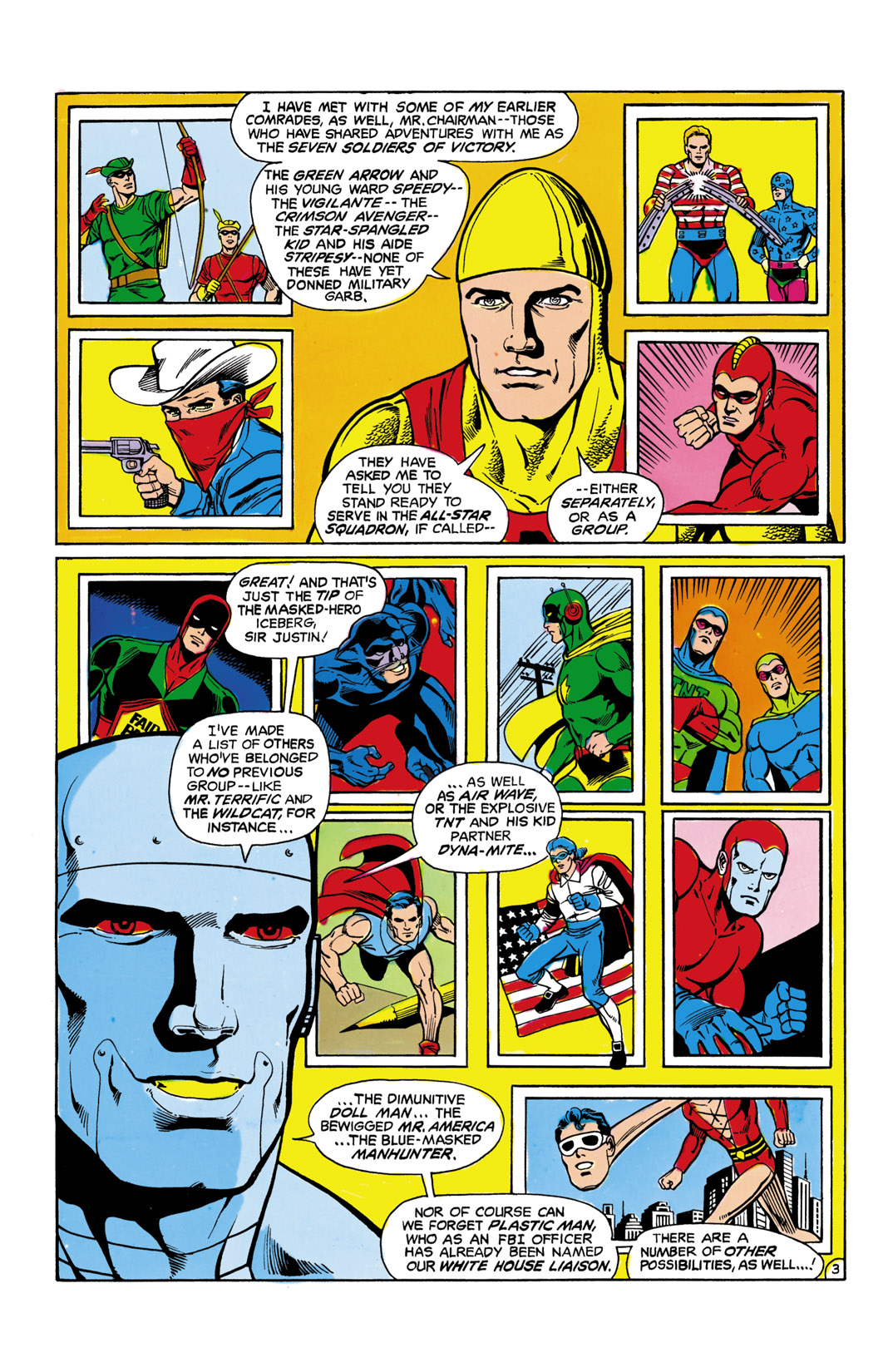 Liberty Belle gives one of those impassioned speeches that sound great in a movie, but that rarely get made in gatherings like that. Anyway, she ends up elected as chairwoman (they aren't quite up to the pC era) of the All-Star Squadron, as Hakman has military duties. Sir Justin announces he is headed to England, with Churchill, as a living symbol of Britain's past. Roy, via Hawkman, reminds us of the Spear of Destiny; so, no invading Fortress Europa. They adjourn and the Hawks, Liberty Belle, Johnny Quick and Firebrand hop a C-47 Skytrain to the West Coast. Firebrand is thinking of her brother and starts spouting racist, but common language of the time period. Liberty Belle kind of cautions her, as Roy seeks to retrofit hindsight into the scene. They land in San Francisco and the Hawks go off to romp in the nest, while the others accompany Danette to a military hospital, where she is reunited with her brother. Meanwhile, Cdr Steel goes to his own reunion, only to find Dr Gilbert Giles dead and his daughter telling him he just as well murdered him, as his heart gave out in relation to Steel's disappearance... 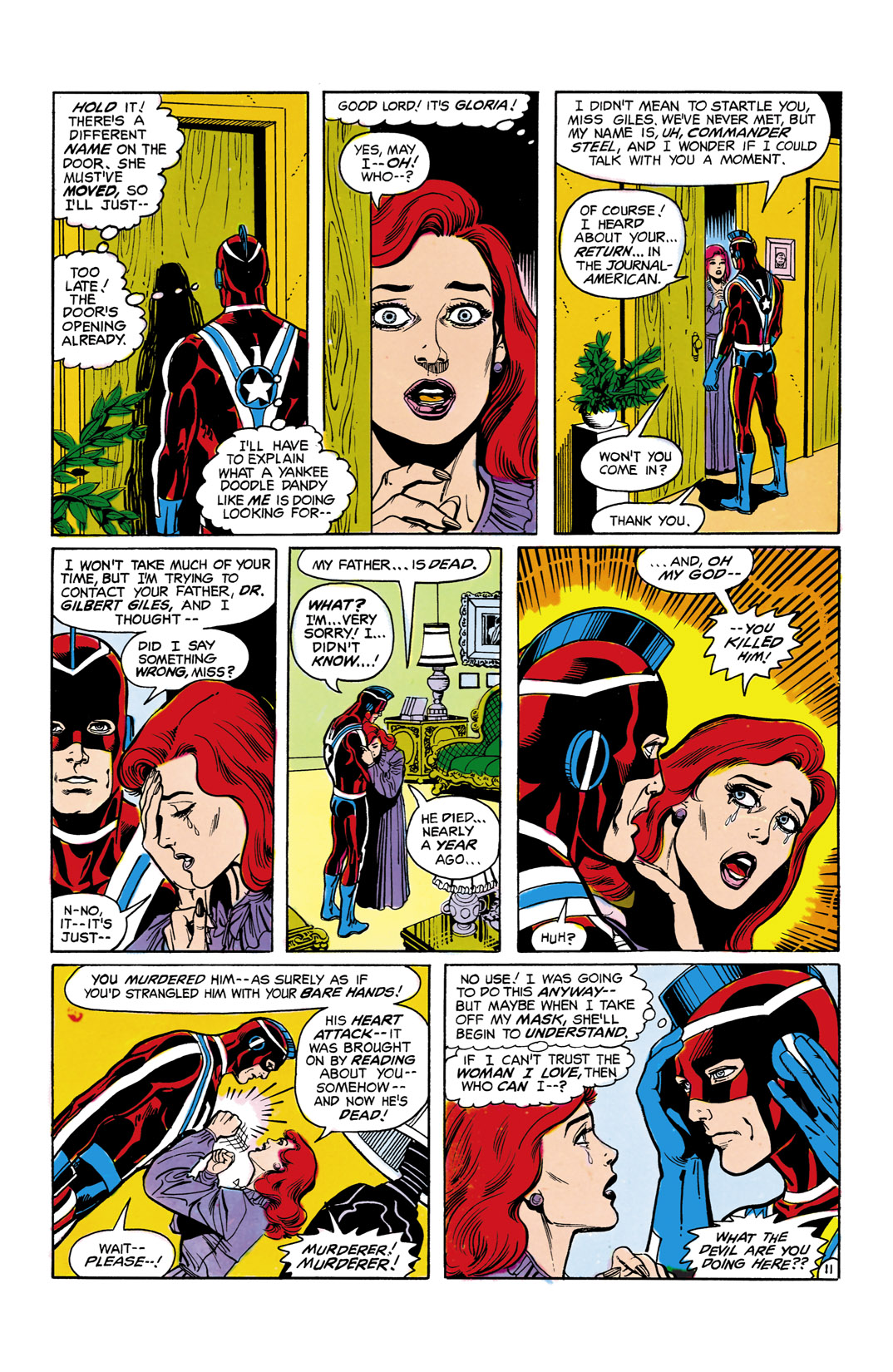 Steel learns that Gloria Giles (seriously? Gilbert Giles, Gloria Giles? Come on Gerry; this wasn't the 60s!), his sweetheart, not only hates him (as Steel), but is now married, to a servicemember about to ship out. He tells Gloria that Hank Heywood is dead and leaves, vowing to himself never to return. So, sucks to be him, though he did bring everyone down. Robotman returns home in time to rescue Chuck Grayson and Joan Carter (his former girl) from a haywire dynamo. He carries off the unconscious Joan, then helps Chuck clean up, then dons a rubber mask and suit to become Paul Dennis, scientist. He is interrupted by a process server, as some lawyer is going to court to have Robotman declared a menace. Robotman lets him know how he feels about the situation... 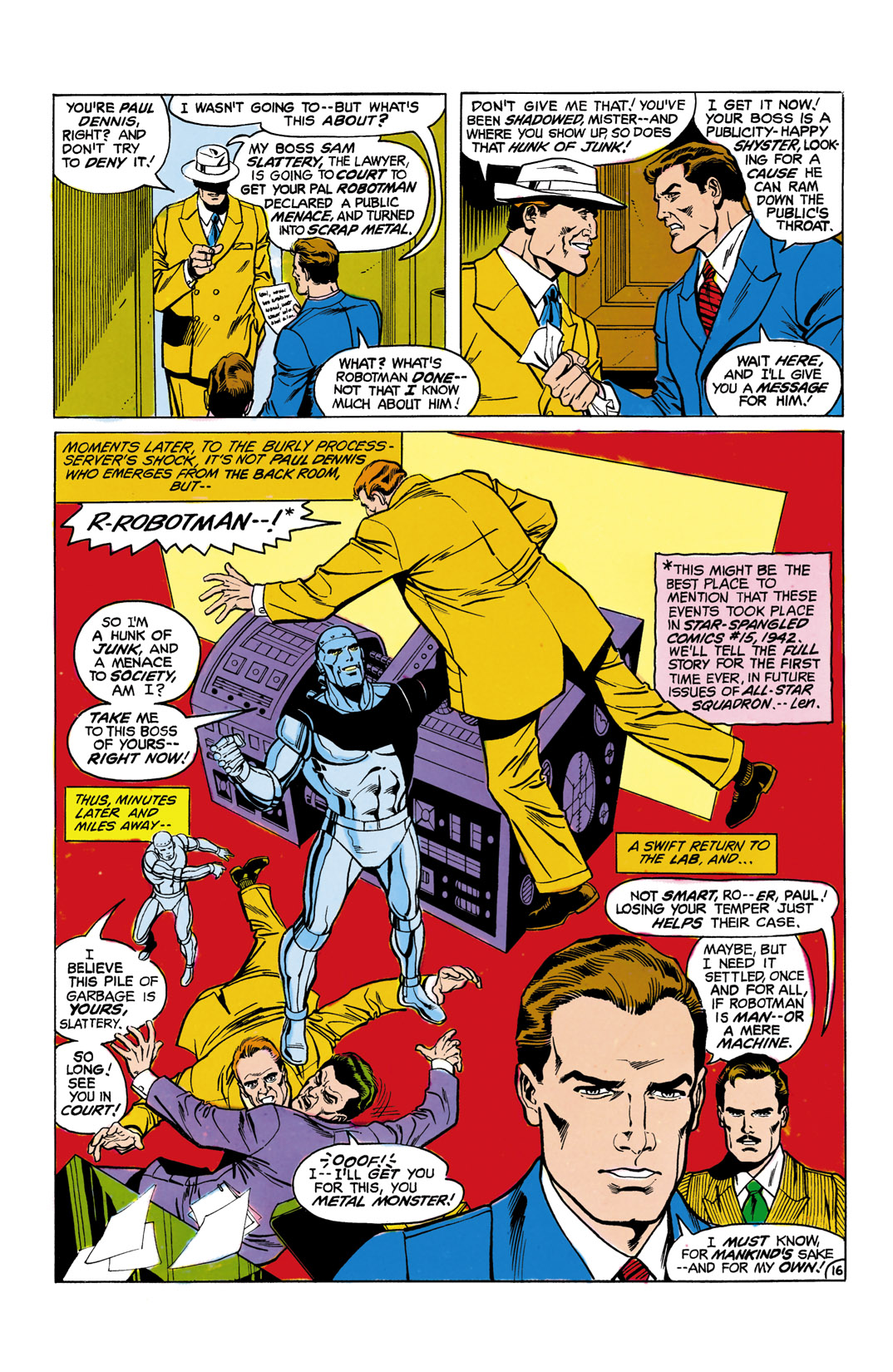 Meanwhile, over the Atlantic, Winston Churchill flies home on a Boeing Flying Boat (which Adrian Gonzales kind of muddles up), with Sir Justin and Winged Victory. They arrive in England during an attack (um, flying boats would land at a port, then Churchill would either move on in a motorcade or via train). Sir Justin "rides" out and jousts with Heinkels. 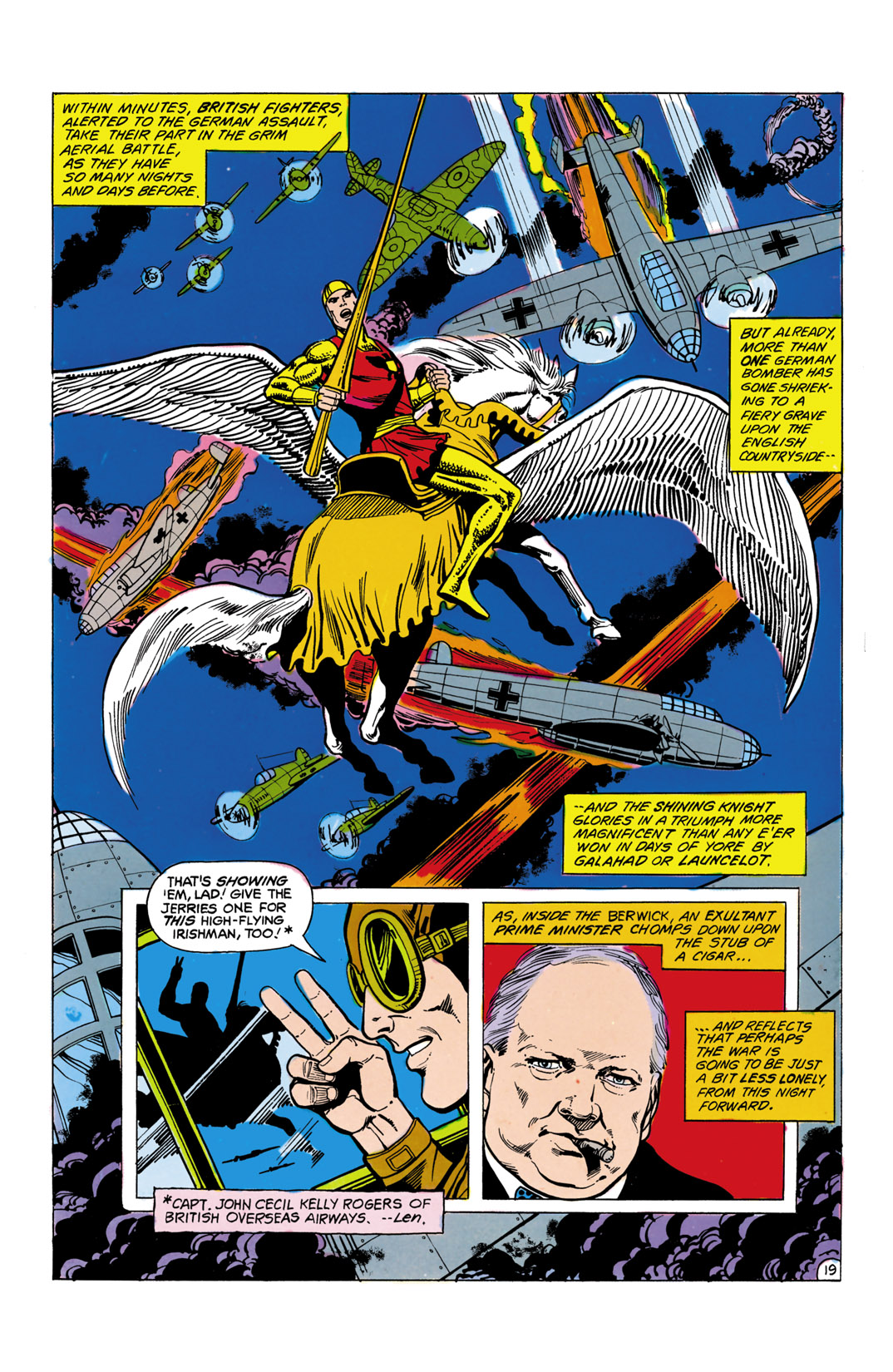 (again, the reproduction isn't particularly accurate) Back in Frisco, Johnny Belle and Firebrand arrive at the hospital and are led to Ens Rod Reilly, who is reunited with his sister. he remarks that she found the closet, reminding us of how Danette, in a daze, found the secret closet where he kept his Firebrand costume. Danette then starts muttering about Japs and Rod sets her straight on the Nisei soldier who saved his life, at the cost of his own... 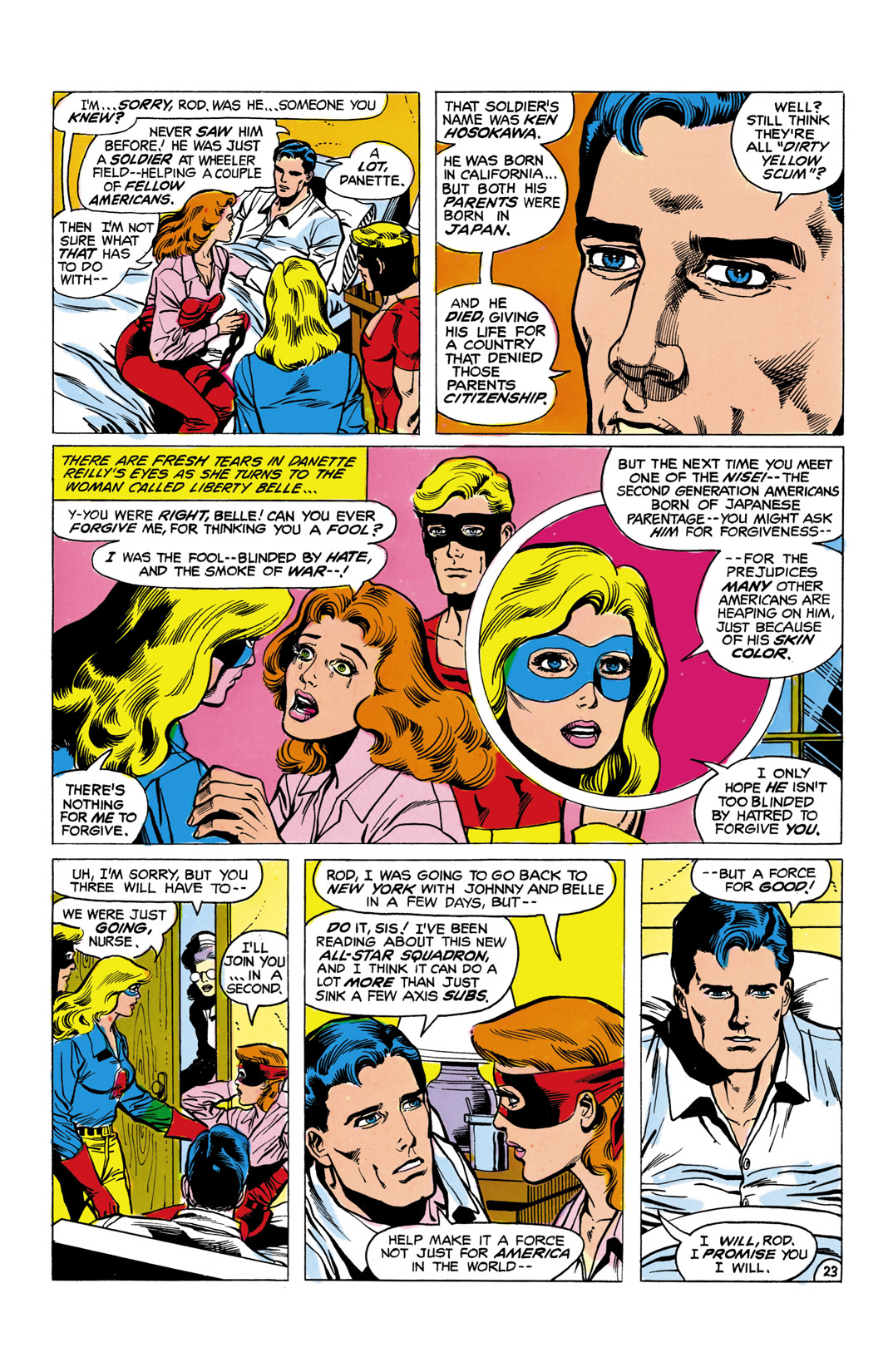 Roy then indulges in some anachronistic hindsight lecturing and then the All-Stars put on a show for the patients in the hospital, though I would think the staff would be a little antsy about flame around oxygen tanks and bed linens. We end with Al Pratt meeting up with his sweetheart at the Jefferson Memorial. We are then told to go read the opening chapter to our next story, in JLA #207, as we get a crossover between the JLA, JSA and All-Star Squadron, across time. However, first we will look at the All-Star Squadron Annual. Thoughts: This was pretty much the epilogue for our first year of the title. We see some quiet time for the All-Stars, and some character development. Liberty Belle becomes the new leader, which is surprising, given the era. However, as they say, Liberty Belle has proven herself and her cool, level-headed leadership. Still, this is 1942 and that's a massive deal. Roy does more than a bit of looking at the past through the lens of today, which inserts commentary into the story, which is at odds with attitudes of the time. Still, a reader in 1982 isn't going to have the same perspective as a reader in 1942. As I said, Adrian Gonzales seemed to lack some period reference, though more in military hardware. He goes for general shapes, but misses on some of the detail. Had this been a war comic, the editor would have never let it fly. We see a subplot developing for Robotman (which is connected to one of his early stories), while Hank Heywood has to say goodbye to his past. no wonder he ends up such a screwed up puppy later, messing up his own grandson. Very good issue, which allows us to reflect and settle for the next adventure. Historical Notes: Winston Churchill did return to the UK on a Boeing Flying Boat, even manning the controls on the leg to Bermuda...  Both Adrian Gonzales and Frank Robbins (who drew the same situation in Invaders), drew the Boeing 314a with wing pontoons, which was not a feature of the aircraft... 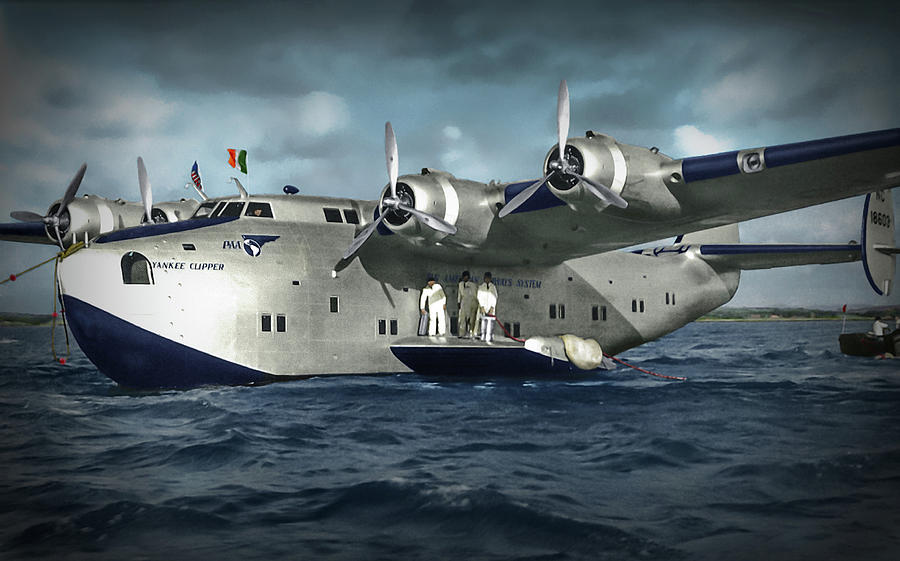 It is possible they were confusing it with the PBY Catalina, a US Navy flying boat that did have wing pontoons...  Gonzales drew gunner and observer emplacements, which definitely suggest the PBY, which, along with pilot rescue, carried out scouting and anti-submarine operations. Gonzales also has problems with the Heinkel He-111 bomber, with its distinctive rounded nose section...  The He-111 was one of the workhorses of the German bombing campaign of Britain, as well as being used extensive in all areas of operation by the Luftwaffe. It was robust, with good speed and was more survivable than some of its Dornier and Junkers counterparts. However, it's crew was concentrated in the nose and it was vulnerable to head-on attacks. It suffered greater losses when employed as a strategic bomber, during the Blitz, rather than as a medium tactical bomber, as in earlier engagements. In one panel, as Cdr Steel runs through the city, a truck can be seen with the logo, Sabatini bros. this is a reference both to the Santini Brothers moving company, which was noted in New York and to rafael Sabatini, author of the swashbuckling novels Captain Blood, the Sea Hawk, The Black Swan, and Scaramouche, all of which were adapted by Hollywood, with Errol Flynn starring in Captain Blood and The Sea Hawk, while tyrone Power starred in The Black Swan and Stewart Granger starred in the most noted version of Scaramouche. During the hospital visit, when Rod talks about the Nisei who saved him, he remarks that he died for a country that denied his parents citizenship. Roy, in efforts to highlight the Nisei soldiers and the internment, jumps the gun. Japanese, German and Italian nationals were declared enemy aliens, but those were foreign citizens within the US. the internment of Japanese Americans did not begin until February of 1942, despite efforts in California, led by Gen John DeWitt, the California branch of the American Legion and the Native Sons and Daughters of the Golden West to have Japanese Americans rounded up and imprisoned as enemy aliens. However, such actions were not pursued in Hawaii, where Japanese Americans lived in high numbers and had for some years, as Hawaii had been the gateway to Japanese immigration to the Americas. Hawaii would prove instrumental in the eventual founding of the 442nd regimental Combat Team. There was a rivalry between the Hawaiian Nisei and the Mainland, with the Hawaiians referred to as "Buta-Heads" and the mainlanders as "Katonks." However, they jelled as a unit and became the most decorated unit in the US Army, with 21 Medal of Honor winners (though 19 were given citations for lesser medals, due to racism, which were upgraded by Pres. Clinton, in 2000), 8 Presidential unit Citations (5 in one month!) and over 18, 000 awards for members, in under 2 years. The movie Go For Broke (the unit's motto), starring Van Johnson, is an early film to dramatize the story of the Nisei. The later film Only the Brave, dramatized the rescue of the Lost Battalion, that cemented the legacy of the 442nd. That was also the subject of a Sgt Rock mini-series, in 2008. In the Karate Kid films, Mr Miyagi was a member of the 442nd and won the Medal of Honor.
|
|
|
|
Post by Prince Hal on Feb 23, 2020 1:41:31 GMT -5
^^ Great, as usual... and I knew you wouldn't call it the Congressional Medal of Honor.
Go For Broke was a favorite of mine when I was a kid; it was my first exposure to the exploits of the 442nd. Every Medal of Honor recipient's deeds are almost unbelievable, but the story of one of the 442nd's heroes' story is astoundingly so.
I refer to one of the 442nd's bravest soldiers, Hawaiian Nisei Daniel Inouye, who earned a battlefield commission to second lieutenant leading the rescue of the Lost Battalion in 1944. There he took a bullet just above his heart, but was saved from almost certain death when it hit the two silver dollars in his shirt pocket.
He earned his Medal of Honor less than three weeks before the end of the war in Europe on the Gothic Line, when despite being shot in the stomach, crawled 15 feet away from two machine guns, and destroyed both. He refused treatment for his wounds, and led an attack on a third machine gun. His right arm was torn in two when he was hit in the elbow just as he was ready to throw a grenade. He screamed at his men to stay back, fearing that the grenade clenched in his right hand, now lying useless on the ground, would explode as his hand relaxed its grip With his left hand, he pried the grenade from his severed fist, threw it and destroyed the German position. Then he was wounded in the leg as he shot the last enemy defender and fell down the side of the ridge before briefly losing consciousness. He regained consciousness quickly and ordered his men to advance, yelling to them, “Nobody called off the war!”
Later he endured the amputation of the rest of his arm without anesthesia.
In a military hospital in Michigan he met another wounded veteran of the Italian campaign, who had fought n the Mountain Division. They became fast friends and would remain so for the rest of Inouye's life. That other vet was Bob Dole.
Inouye earned the Distinguished Service Cross for his action on the Gothic Line, but it was upgraded to a Medal of Honor in 2000.
HIs injuries ended Inouye's plans to go to med school, but in 1959 he was elected one of the new state of Hawaii's first two senators and served until his death in 2012.
|
|
|
|
Post by codystarbuck on Feb 26, 2020 20:31:30 GMT -5
All-Star Squadron Annual #1 Cover from Da' Ordster. All-Stars vs the 50 Ft Charles Atlas! Creative Team: Roy Thomas-writer, Adrian Gonzales-pencils, Jerry Ordway-inks, John Costanza-letters, Carl Gafford-colors, Len Wein-editor. I assume this was why Ordway skipped issue #13. The story's title, "The Three Faces of Evil," is a reference to the novel (and later film) The Three Faces of Eve. Synopsis: Green Lantern, Wonder Woman and the Flash are at it again, performing for a war bond drive circus. The boys appear to be attempting to make a WW sandwich, on the high wire. Kinky. The crowd starts to get a bit restless and the heroes go into a worked catastrophe, as the tightrope breaks, WW catches Flash and GL fashions a trapeze, as they go into an acrobatics spot. Johnny Chambers' cameraman, Tubby Watts, is there filming and the Flash goes into his ten revolution somersault, which gets interrupted by bright lights and he misses GL. 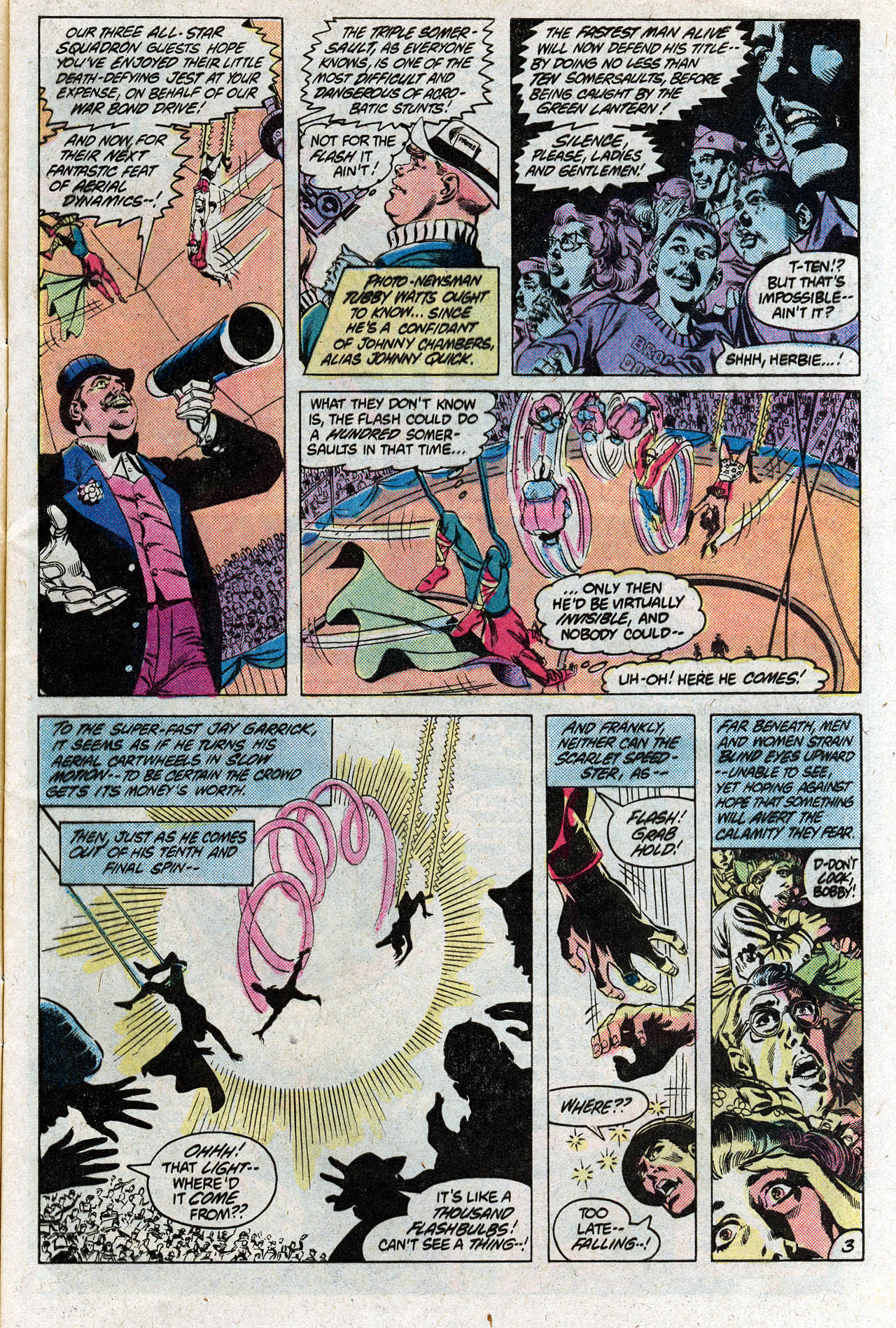 He lands safely and the others descend and the see the source of the lights: Atom, Wildcat and the Guardian all encased in a golden sphere of light. The sphere lands and they rush out and attack the JSAers, with Wildcat getting a fast kayo on GL. Flash & Wonder Woman run circles around Atom and Guardian (who no one recognizes), but Guardian is able to perceive the Flash and land a right to the jaw, then Flash runs smack into his shield. Atom is able to match WW's speed and grabs her by the wrist, which gets him judo tossed to the sawdust. the crowd thinks it is all part of the show. GL has recovered and tries to grab Wildcat with a ring-created hand, which Wildcat shrugs off. GL hits all three with a green orb blast, which seems to bring the trio out of their state, as Atom asks what's going on? GL whips them all out of the tent on a magic carpet (lantern ring created, of course), where Wildcat relates his backstory. Ted Grant helps heavyweight champ Socker Smith deal with some muggers and is trained by the champ, at Williams Gym, where he goes on to win the New York State Boxing Championship, from Socker, who dies in the ring. the cops try to pin it on Grant, who puts on a cat suit and proves his innocence. he then continues fighting crime outside the ring and palookas inside the squared circle. 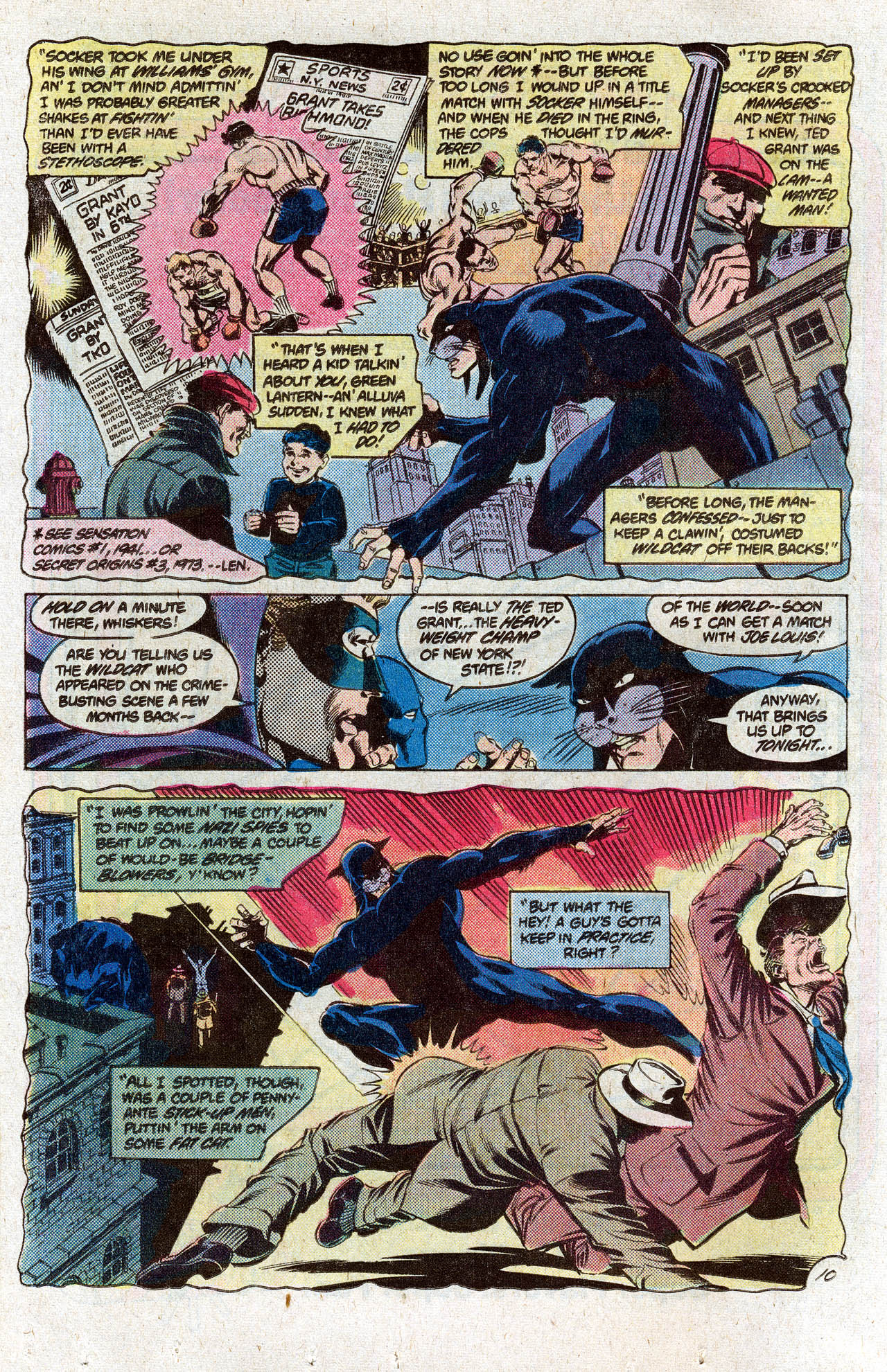 He was dealing with some hoods, when he was sucked up by the glowing sphere. the same thing happened to the Atom and Al pratt tells his story. It's pure Charles Atlas as the bullied Pratt helps out a derelict, who turns out to be a famous fight trainer, who makes a man out of Al, then trains him as a fighter! (Just kidding). Al becomes the Mighty Atom (well before a certain Japanese boy robot) and kicks crime's butt. he said goodbye to his girl as he shipped out on a troop train and was sucked up by the glowing sphere. Next, it's time for the guy in the yellow crash helmet. Jim Harper relates his life in Suicide Slum, stealing apples with his pal Leo. He is caught by a guy who turns out to be an alright joe, who trains him and sets him on the right path. he becomes a top gymnast, with a future in the Olympics, but goes off to find out what happened to Leo. he traces him down, but he is running with the mob. He's hiding, after bumping off a rival, when he is gunned down in the street. jim Harper decides there and then to become a cop. He gives up sports and goes on a beat, in Suicide Slum. The people don't see him as a friend and he is pelted with tomatoes. later, off duty, he is attacked by a gang of thugs and left for dead. When he comes around, he breaks into a nearby costume shop, puts together and outfit (and leaves some money behind; he's a hero, after all) and goes hunting for the hoods.  He hogties them for the cops and departs and ends up sucked up in the sphere. Wonder Woman's Lasso of Truth proves he is telling the truth. They figure that the trainer is the common link and GL uses his ring to probe their minds and create a visualization of each man. Atom identifies his trainer, Joe Morgan, who turns out to be the same coach that trained Ted Grant in football (before the Depression) and Jim Harper in gymnastics. They go hunting for Joe Morgan, or Nat Milligan, as Harper knew him. they go looking at the former addresses of the men they knew. Jim Harper leads Flash to a Suicide Slum tenement, where Nat Milligan had an apartment. inside they fin him, enveloped in a purple aura, who then sends energy bubbles after them. Flash avoids them and Guardian kayos Nat, who then starts changing. Atom and Wonder Woman go to the farm where Joe Morgan trained Al Pratt and a similar thing happens, except Joe Morgan has a blue aura and Wonder Woman knocks him out, before he starts changing. finally, Wildcat and Green Lantern go to Williams Gym, where a yellow-auraed Joe Morgan is in the ring. Same thing, though Wildcat gets the decision. They all meet back up, each with an unconscious Joe Morgan/Nat Milligan, in his skivvies. They lay them side by side, where they unite into one big glowing Joe Morgan, who attacks. 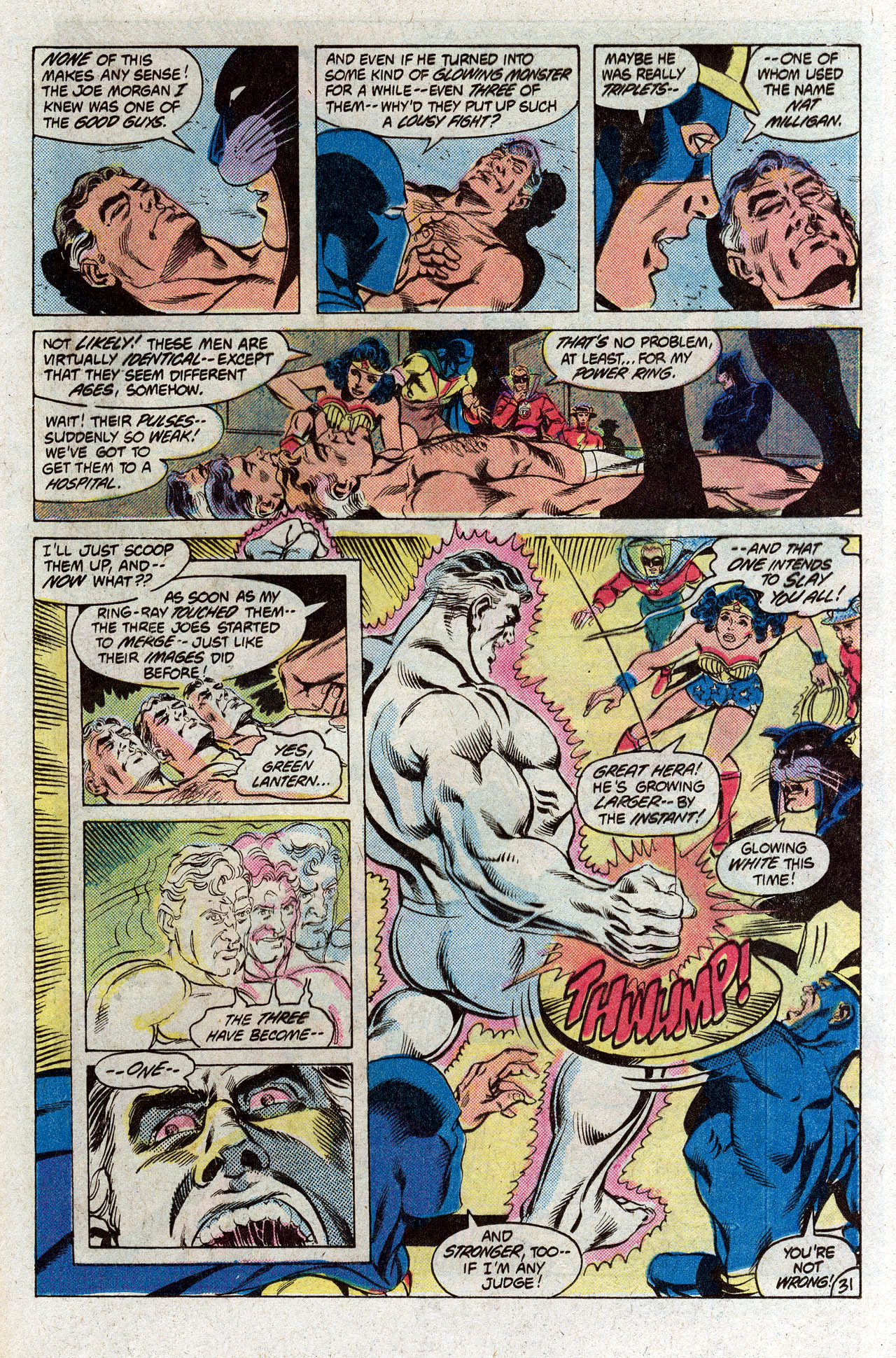 He holds off the combined might of the group, until the three students take down the master, while appealing to the man within. Eventually, the sphere dumps Joe Morgan and is caught by GL's ring. Morgan tells of the orb swallowing him up and then dispatching the spheres to catch the students and splitting him into 3. it fed on his bitterness, like a parasite. Morgan dies and the team moves on. The epilogue (or prologue, as labeled) reveals the origin of the sphere... 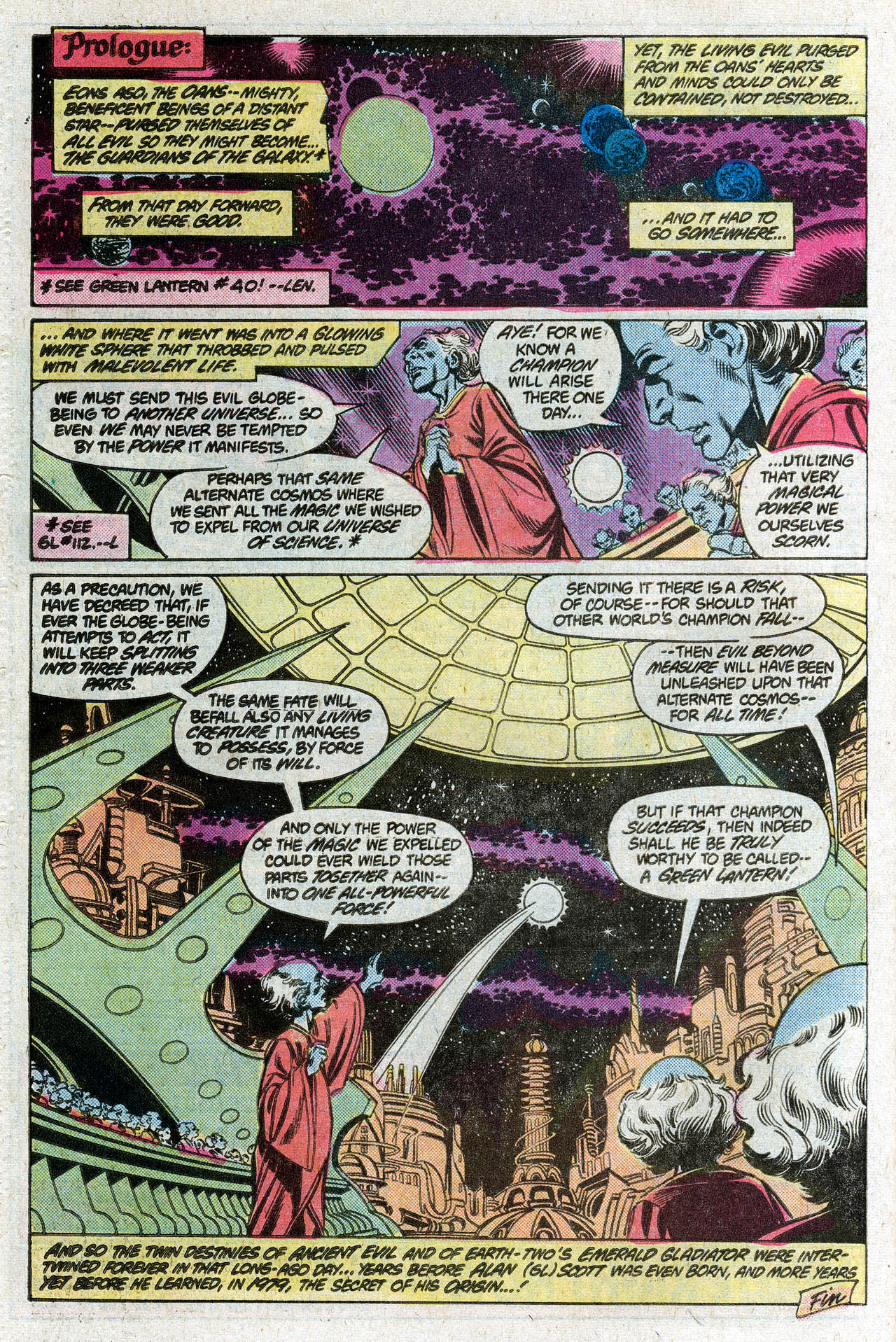 The Guardians of the Universe, which exist in the dimension where Earth-1 resides, expelled all evil from themselves, which took the form of an orb. they sent it off into the same dimension where they dispelled magic, which is where Earth-2 was. That would take is full circle, where it would take another Green lantern to defeat the evil they cast off. We finish off with fact files on Wonder Woman, Green Lantern, Flash and Guardian, plus the Newsboy Legion. Thoughts: Excellent tale as Roy Thomas tries to reconcile the similar origins of three physical heroes and gives them a common link. there is a continuity error, as Joe Morgan appeared in the atom comic for several adventures, though Al says he left in a huff when he took up crime fighting. All three characters were basically riffs on old sports stories. Atom was the whole Charles Atlas ad, as he makes a Man Out of Mac. Those ads ran for decades in comics, from the Golden Age on. Even Terry Gilliam spoofed them on Monty Python's Flying Circus. Wildcat's origin was an old boxing story cliche, with every fighter who was told by the mob to throw a fight or who fought someone who died in the ring, such as Trooper Thorn, John Wayne's character in The Quiet Man, a boxer who kills a man in the ring and comes home to Ireland to try to find peace, Jim Harper is a bit of Jack Kirby, mixed with the Dead end Kids stories. Jim Harper's pal Leo is named for Leo Gorcey, who starred in the film series, based on the original play and film, starring Humphrey Bogart. Kirby grew up in Hell's Kitchen and fought in neighborhood gangs; but, his drawing gave him a way out. Jim Harper becomes a cop, after physical fitness got him out and then becomes a Guardian to the neighborhood and the Newsboy Legion, a gang of newspaper boys who have a penchant for getting into trouble. Guardian was overshadowed by the Newsboys, as would Rip carter, with the Boy Commandos and Daredevil, with the Little Wise Guys. All-in-all, this is a great little stand-alone that helps introduce modern readers to new characters (Guardian was all but unknown to most, especially if you came in after Kirby's Jimmy Olsen run with the clone Guardian). I had seen the Guardian costume in use in teen Titans, but didn't see the Kirby stuff until later. It also gave more of Wildcat, who was a visual favorite, though he wasn't used as often in the JLA/JSA crossovers of the 70s. Atom was a stalwart of the early All-Star Squadron issues and his look always made him a favorite, for me. Historical Notes: not much to cover, except some of the inspirations for these characters and situations. Charles Atlas was born Angelo Siciliano, in 1892, in Cosenza, Italy and emigrated to the US in 1903, settling in Brooklyn. he was a leather worker who was interested in physical fitness, but too poor to join the YMCA. He was influenced by strongman Eugene Sandow and Physical Culture publisher Bernarr McFadden. He developed his own Dynamic Tension method, mixing isometric and other exercises for fitness, combined with diet and training methods of strongmen performers and weightlifters. His course was sold in the pulps and comics for decades, purporting to turn a 97 pound weakling into a he-man in a matter of weeks. The image of Atlas would provide the inspiration and legal problems for Flex Mentallo. In the story, Ted Grant name drops the world heavyweight boxing champion, Joe Louis. Louis was a top amateur who moved up into the pro ranks, though held back by the racism that dominated, especially after Jack Johnson's reign as heavyweight champion, and marriage to a white woman. Johnson was done up on charges under the Mann Act and forced into exile, fleeing to Europe. He lost the title in Cuba, though he intimated that he took a dive, though historians dispute that. He returned to the US in 1920 and served a year in prison. Louis fought German fighter Max Schmeling in a contenders bout and suffered a 12th round knockout. Schmeling was the darling of Nazi Aryan propaganda and they promoted his win as proof of Aryan superiority. Meanwhile, Heavyweight Champion Max Baer (father of Max "Jethro Bodine" Baer Jr) was defeated by James J Braddock (subject of the film Cinderella Man), in a surprise upset. Schmeling wasa logical contender for the title; but, Braddock and Louis' managers had been angling for a Braddock-Louis fight. The loss to Schmeling gave them leverage to get 10% of Louis earnings for the next 10 years. Madison Square Garden had a contract for a title defense and wanted Braddock vs Schmeling. Braddock's manager set the Braddock-Louis fight for Chicago, figuring the New York State Athletic Commission wouldn't sanction it. Louis met Braddock on June 22, 1937 and, despite being knocked down in the first round, Louis knocked out Braddock in the 8th, knocking his teeth through his gum shield. Louis and Schmeling got their rematch, for the title, with Louis brutalizing Schmeling, until his corner threw in the towel, in the first round. He dominated the heavyweight division into the 1940s. Louis fought a charity fight to raise money for the war effort in January, 1942, then enlisted in the Army. He was put into a segregated cavalry unit, before moving on to Special Services. While serving in the Army, he was instrumental in helping black soldiers fight racism by guiding them to legal counsel from friend Truman Gibson. Louis was instrumental in recruiting African-Americans, despite segregation, pointing to the Nazis and Japanese as greater enemies and pointing to the future to fix America. he is alleged to have helped prevent Jackie robinson from being charged for striking a superior officer who used a racial slur against him. Louis returned to the ring, mostly because of tax difficulties and faced undefeated Rocky Marciano, in 1951, in a fight Marciano didn't want to take, but did so only because Louis needed the money. It was the end of Louis career, as he was knocked out in the 8th round. Marciano apologized to Louis, who told him to forget it, that the better man had won. Louis was plagued by tax problems for years and hustled any paying appearance he could find, from game shows to even becoming a pro wrestler, in 1956. He soon found he had heart problems and gave up wrestling, but worked as a referee until 1972. He was also a subject of scorn by some, in the Black community, labeled an Uncle Tom for being to amenable to White Authority, including by Muhammad Ali. However, history proved far inder, as did his former opponent, Max Schmeling, who respected the man, even for his faults.
|
|
|
|
Post by zaku on Feb 27, 2020 1:56:50 GMT -5
The Guardians are really a bunch of jerks! :-(
|
|
|
|
Post by codystarbuck on Mar 7, 2020 17:27:56 GMT -5
Justice League of America #207 Wait, why is this here? Wait, why is this here?Ahhhh, wait and see, young grasshopper! Like the way the character heads react to the center image of the Crime Syndicate attacking the JLA. That's right, folks; The Crime Syndicate of Earth-3, for a Crisis on Earth Prime. Get out your Who's Who in the DC Universe collections now.... Creative Team: Gerry Conway-writer, Don Heck-pencils, Rome Tanghal-inks, Ben Oda-letters, Carl Gafford-colors, Roy Thomas-"plot consultant", Len Wein-editor This is the 20th Annual JLA/JSA team-up, which means it's big. We've got the JLA, JSA, All-Star Squadron, Crime Syndicate, a familiar villain, and a prelude to what was to come in 3 years. Not that Gerry Conway would get to write that... Synopsis: It's time for the annual JLA/JSA crossover. Starman has the potato salad and Huntress made deviled eggs. Power Girl has the melons....I mean brought along a fruit tray. They warm up the matter transmitter to cross from the incorrectly numbered Earth-2 to meet up with the youngsters on Earth-1. JLA chairperson Zatanna gives Superman the go-ahead to open the circuits so the old-timers (relatively speaking) can come through. Hawkman is excited, as Starman has come out of retirement (need to keep that trademark alive). Dr Fate, Green Lantern, Starman, Power Girl and Huntress step into the matter transmitter and out pops Jeff Goldblum, on the other side.... no, wait, that was The Fly. Out pops.... 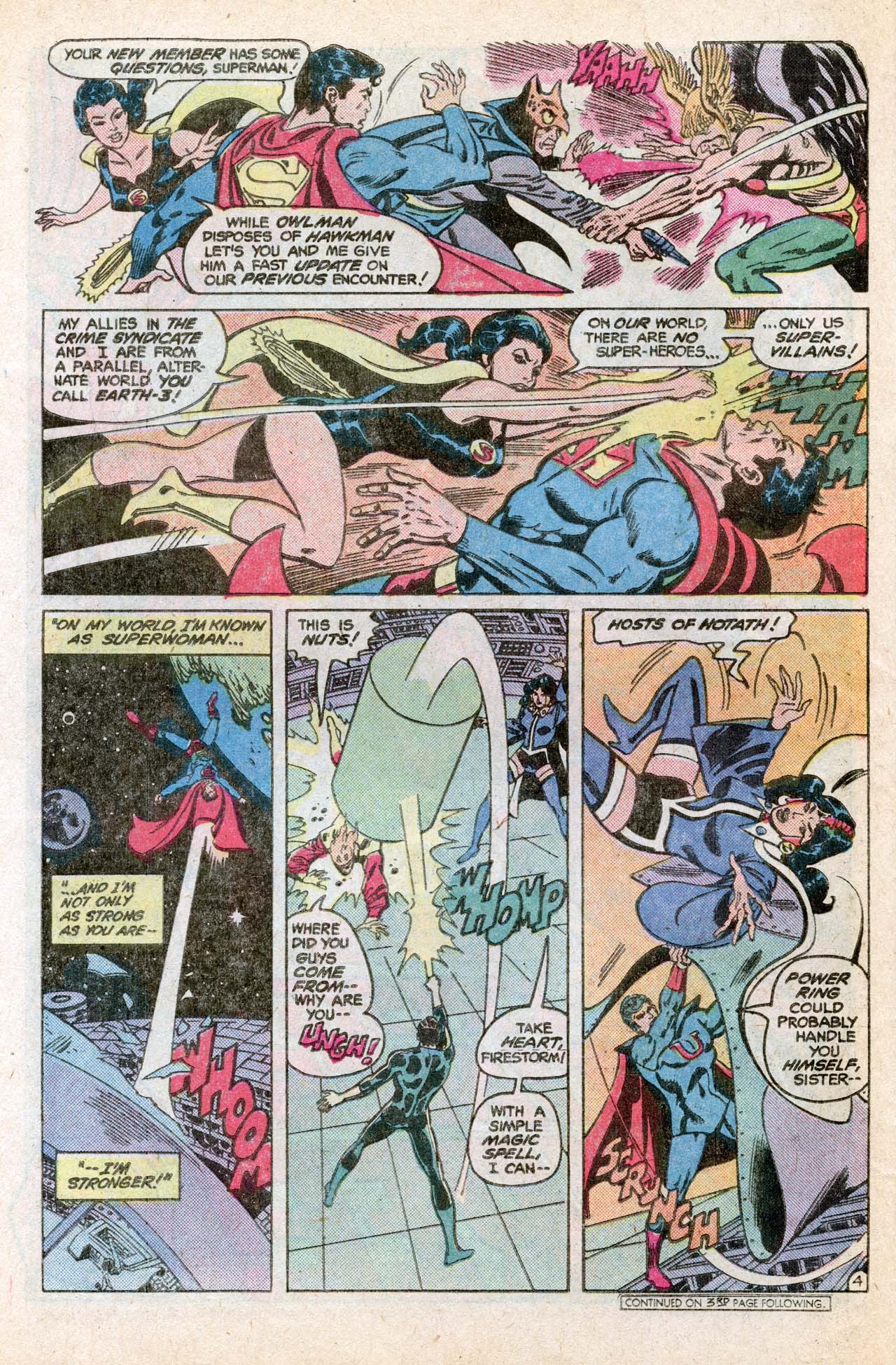 The Crime Syndicate of America, former rulers of Earth-3, where there are only super-villains. That is, until they faced the combined might of the JLA and JSA and were imprisoned in limbo (without trial I might add, rather like GITMO). They reintroduce themselves, with punches and kicks and defeat the JLA. They then steal a rocket to go get revenge on Per Degaton. Wait....what? Per Degaton? You mean the red-headed "Moe", who fought the Al--Star Squadron in their first adventure? Yep, didn't take him long to reappear. Meanwhile, Gerry Conway asks the question, "What happened to the JSA?" well, they are locked in the prison cell, in limbo, in place of the Crime Syndicate. Dr Fate fills in Huntress and Power Girl about the CSA (the villains, not the Confederacy) and Power Girl tries to punch her way out. That fails, since it was designed to withstand Ultraman's strength and GL is useless, since it could stop Power Ring's....er...ring. However, it isn't up to Dr Fate's magic and Starman's Cosmic Rod. So, after a blast of ankh power and one of phallic cosmic energy, they are free. Green lantern finally proves useful by using his ring to locate the "tear in reality", where the CSA escaped into another dimension. It takes them to Earth-Prime, our world, which is toast! 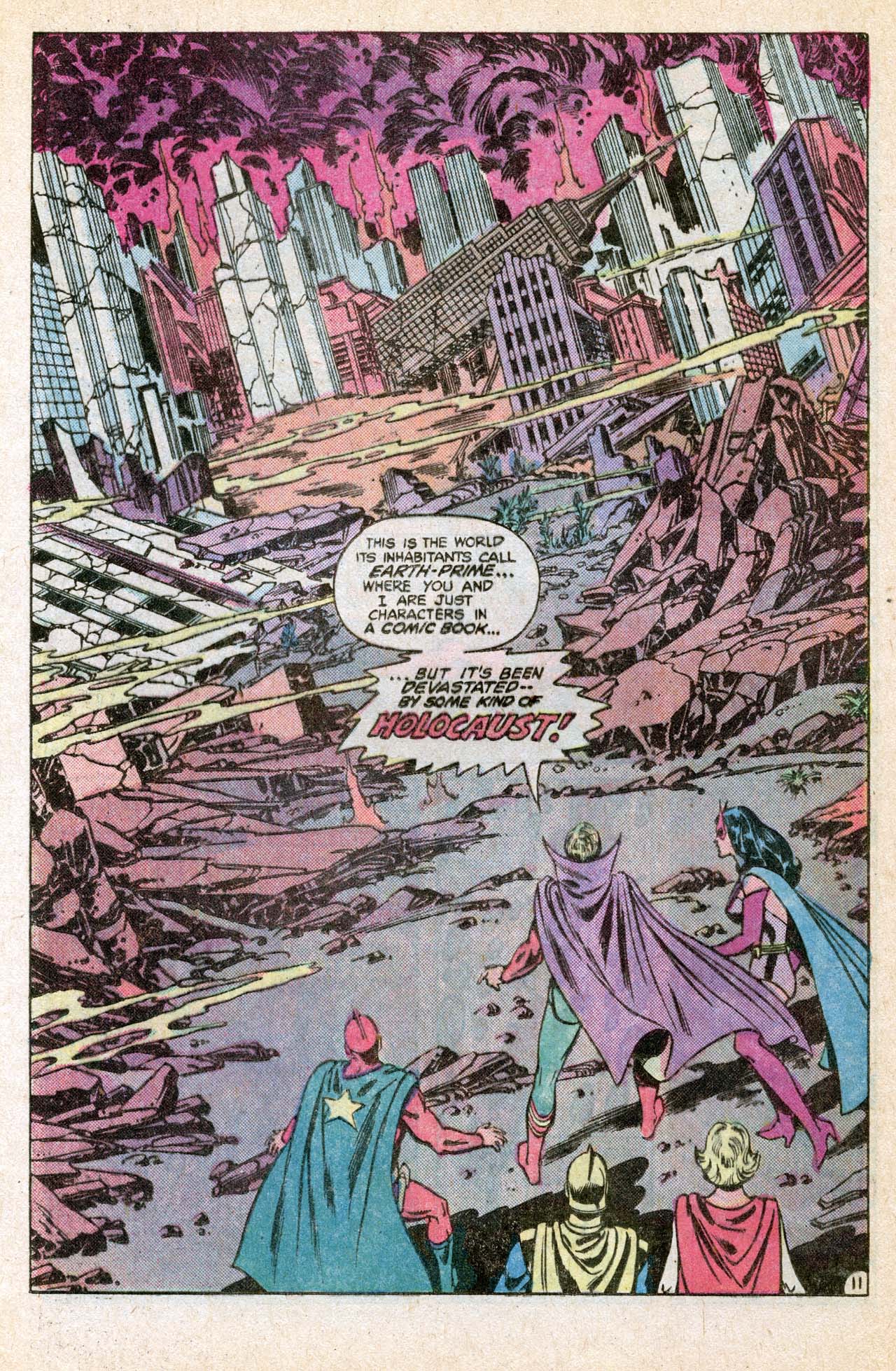 Wait....if our world was destroyed in some holocaust, how are we reading the fictional adventures of these heroes, since that is how they exist on our world? What of noted Earth Prime citiznes, like Julie Schwartz, Cary Bates and Elliott S! Maggin? What of Ultra, hero of Earth-Prime? They figure out the nuclear holocaust occured in the past, due to climate changes (bit of a stretch; but, hey, comics!). They survive an attack by mutant plants and then GL uses his ring to trace the psychic patterns of the cause of all this: Per Degaton! Lot of love for a guy who is pretty much a loser. Meanwhile, the JLA have come to and Superman rescues Zatanna from dying in space. They take the matter transmitter cube to Earth-2, to find out what happened to the JSA and find their meeting room trashed. it's also covered in cobwebs, which means its been deserted for some time (or they are too cheap to hire a cleaner). The calendar shows 1942; but, Superman sees something different outside. They head out and find, thanks to a glimpse of legs in seamed stockings, old DeSotos and similar cars that the world looks like the 1940s, yet a news feed on a building says it is 1982. They also see dozens of statues of Per Degaton. The locals seem to be anxious and suspicious of everyone and Zatanna tries to ask a lady a question and she freaks out about them being dressed like the "Forbidden Ones." She shrieks and out come a rather fascist looking police (I know, I know....some would say that is redundant; but, this is not a Billy Jack movie). 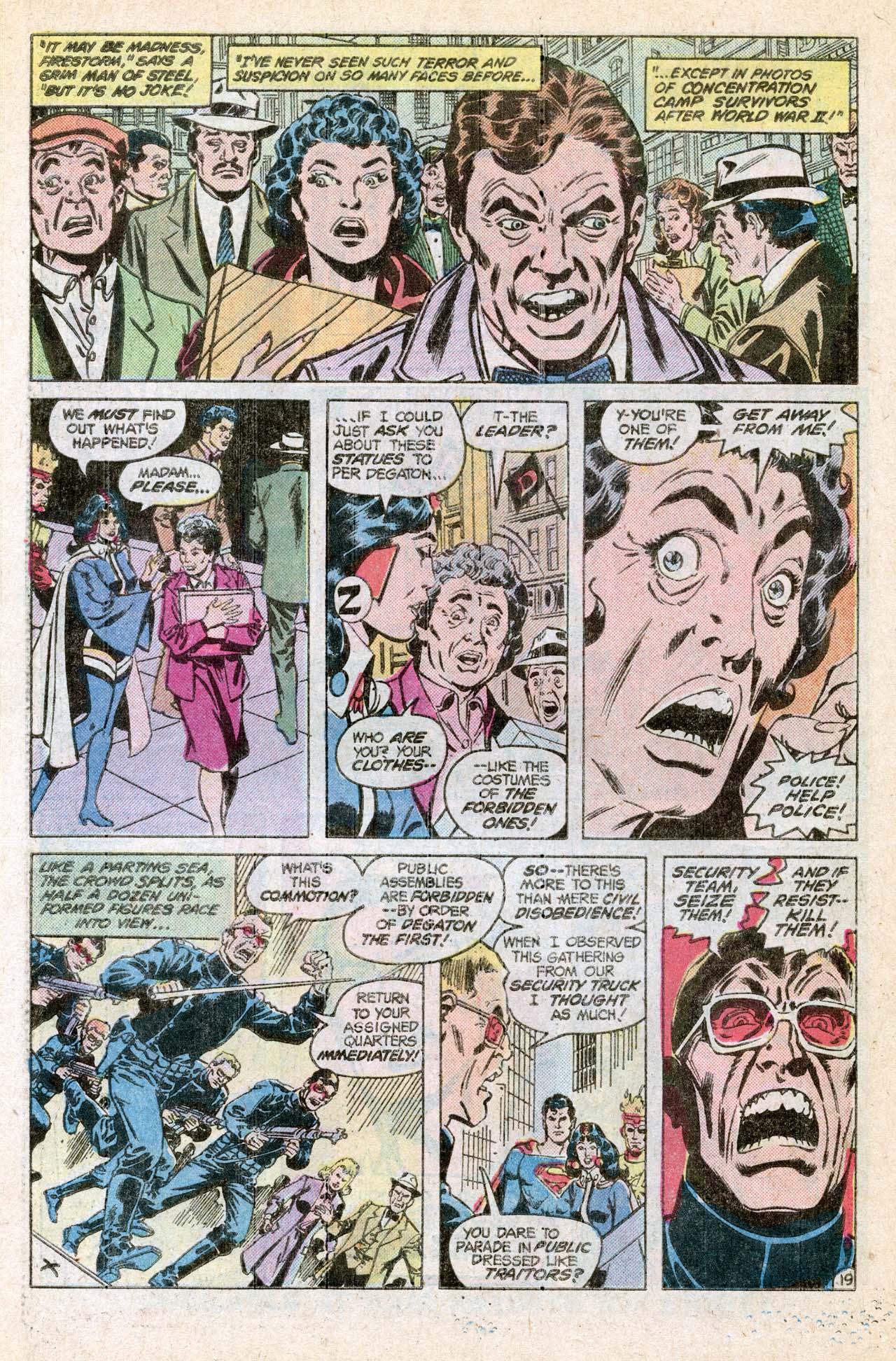 They open fire and Superman laughs at them as the bullets bounce off (bet he ducks if one of them throws his gun at him) and then Zatanna casts a spell that blows them away. Firestorm creates a sphere for everyone to ride inside and Superman propels them back through the time stream to 1942. They arrive at the JSA mansion and it is pristine. They look around when a doorknob turns and in walks.... 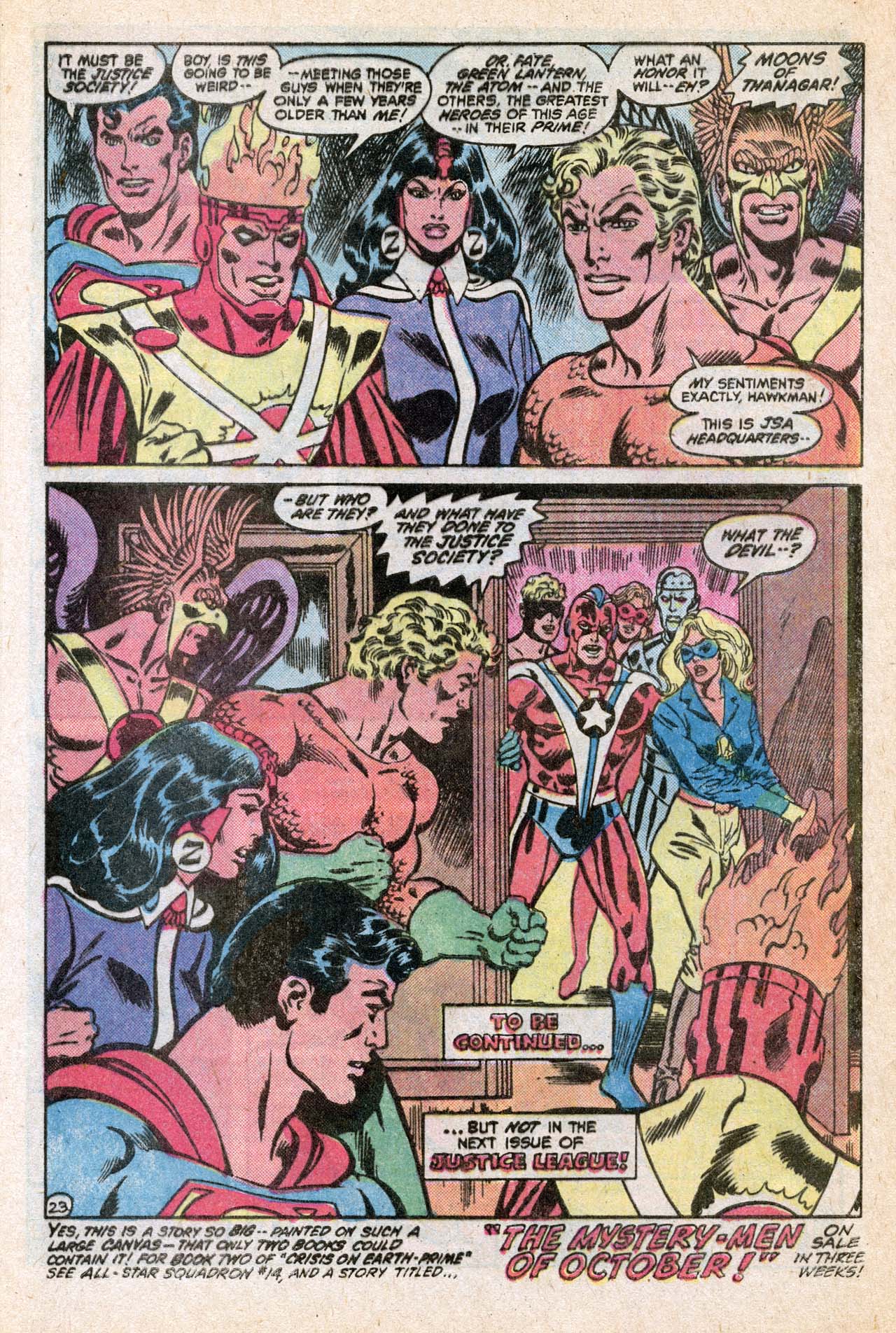 We are told that we have to go read All-Star Squadron #14 for the next part. Thoughts: Speaking as a general comic book story, this is an interesting mystery. Speaking as a JLA reader, the formula of time travel mysteries and reviving old characters is a bit thin; but, there is enough here to forgive the recycled ideas. Speaking as an All-Star Squadron reader; this is a bit of a rip-off, as they get a one page cameo! The Perez covers are great and would be copied again and again. they, themselves, are homages to some of the earlier JLA covers, with similar character heads bordering a central image, though George makes them look like they are reading along with us. The CSA was in a revival (trademark renewal time) as Power Ring, Super Woman and Johnny Quick guest-stared in The Secret Society of Super-Villains, where they got their butts kicked by Captain Comet (That's gotta suck!), and Ultraman ended up on the losing side of a battle against the original and Earth-1 Supermen and Alexander Luthor, the first hero of Earth-3. This was in DC Comics Presents Annual #1, an excellent story where the Golden and Silver Age Superman meet the Earth-3 Luthor, who uses science to become a hero, while Ultraman is teamed up with Earth-1's Lex Luthor, and Earth-2's red-headed Alexander Luthor, would be dictator. It's a bit son after to have another red-headed schmoe plaguing the parallel worlds. Sadly, George Perez only did covers; but, for Don Heck, in the 80s, the art is pretty decent. Don't know if he just stepped it up or if Romeo Tanghal is cleaning things up. Some parts don't look very Heck and some are very much his work. Heck gets a bad rap and was a good artist (especially if he got his kind of material) but was a fair superhero artist, depending on his inker. he did some great Avengers stories and could handle a crowd; but, his DC work of the late 70s and early 8s was not his best (and health was a contributing factor). Here, though, his work looks fine. I have to wonder, though, about the conceit of Earth-2 being stuck int he 40s, after Per Degaton pulls of his conquest. Even under dictatorships, things don't stagnate that much. If you look at Nazi Germany, where they are making obvious comparisons, there were dynamic changes in industry, transportation and other areas. The Volkswagen Beetle was introduced as a cheap car for the working man, while the elite had their higher end Mercedes and such. There is no reason for things to be that stuck in time, without some form of mysticism. perhaps the next part will explain things; but, I think it is more lazy visual storytelling than design. I get that they want to tie into 1942, specifically to bring in the All-Star Squadron; but, it doesn't make sense, if you think about if for more than the time it takes to read the page. After the Perez drawn (well, mostly drawn) previous team-up, this is my second favorite crossover of the era. I am partial to the one with the historical figures (Viking Prince, Enemy Ace, Jonah Hex, Miss Liberty); but, hated the Lord of Time as the villain. I'm not keen on Per Degaton; but, in Roy's hands he is far more interesting than the LoT was in Conway's. Historical Notes: 1982 I got my driver's license that fall, though just before my grandfather died. Ozzy Osbourne bit the head off of the bat and was arrested for urinating on the Alamo, Pat Benatar married Neil Geraldo and they are still married to this day (a miracle, in rock n roll), MTV is barely seen and has practically no sponsors and most of the videos are either fromEurope or are concert footage (or from experimental bands, like Devo, Talking Heads and Utopia), Michael Jackson releases Thriller, "Eye of the Tiger" is the number one hit, Rocky 3 revives the fortunes of the franchise and gives Mr T's career a major boost (and Hulk Hogan, for that matter), some guy called Prince is talking about parting like it's 1999, Nicholas Meyer saves the Star Trek franchise after a tepid first movie, ET phones home and sells Reese's Pieces, Richard Gere learns about what it takes to be An Officer and a Gentlemen (despite the US Navy). The San Francisco 49ers defeat the Cincinnati Bengals to win the Super Bowl. Joe Montana is the MVP. Tottenham Hotspur beat Queen's Park Rangers to win the FA Cup. Italy defeats West Germany to win the World Cup. The NFL goes on strike and the season is cut in half. St Louis Cardinals defeat Milwaukee Brewers 4 games to 3 to win the World Series.North carolina defeats Georgetown to win the NCAA Men's Tournament. Louisiana Tech wins the Women's division. The LA Lakers beat the Philadelphia 76ers 4 games to 2 for the NBA Championship. Larry Homes successfully defends the WBC title against Gerry Cooney (yet another "Great White Hope"), Ray "Boom-Boom" Mancini defeats South Korean boxer Duk Koo Kim in Round 14, by knockout and Kim dies 5 dies later of ring-related injuries. NY Islanders win the Stanley Cup 4-0 over Vancouver. Prince William and future bride Kate Middleton are both born, as are future presidential candidate Pete Buttegieg, Dr Who Matt Smith and 1st new doctor companion Billie Piper, race car driver Danica Patrick, singers Kelly Clarkson and Adam Lambert, future Bucky Sebastian Stan and maria Hill-Cobie Smulders , near future Oscar winner Anna Paquin (and future mutant). King Tut, Victor Buono dies, as well as: Hans Conried (Snidely Whiplash, capt. Hook and Wrong Way Feldman), Paul "Uncle Arthur and Hollywood Squares" Lynde, Thelonious Monk, Phillip K Dick, John belushi (of a massive drug overdose), Steve Ditko's guru Ayn Rand, Henry Fonda, Sir Douglas bader (RAF ace who wore a prosthetic limb), Grace Kelly, Criswell (bet he didn't see that coming), Leonid Brezhnev, Marty Feldman, The Commodore 64 computer arrives in homes, the government breaks up AT& T's monopoly (remember the days of breaking up monopolies?) , the first computer virus infest Apple-II computers, thanks to infected floppy disks (remember those?), a syzygy of the solar system occurs and the world survives, the Argentine military invade the Falkland Islands and give Margaret Thatcher an excuse to exercise military might and ensure re-election, Israel withdraws from Sinai then invades Lebanon, Vic Morrow and 2 child actors are killed during the filming of a scene for the Twilight Zone movie, several people die in poisonings of bottles of Tylenol in Chicago , the Vietnam War Memorial is dedicated and Time's Man of the Year is the home computer.
|
|
|
|
Post by codystarbuck on Mar 7, 2020 20:03:04 GMT -5
ps Owlman looks like a complete dork in that outfit. I have to think Spider-Man or the Human Torched would have laughed him off into a costume change, as they did Paste Pot Pete, aka The Trapster. 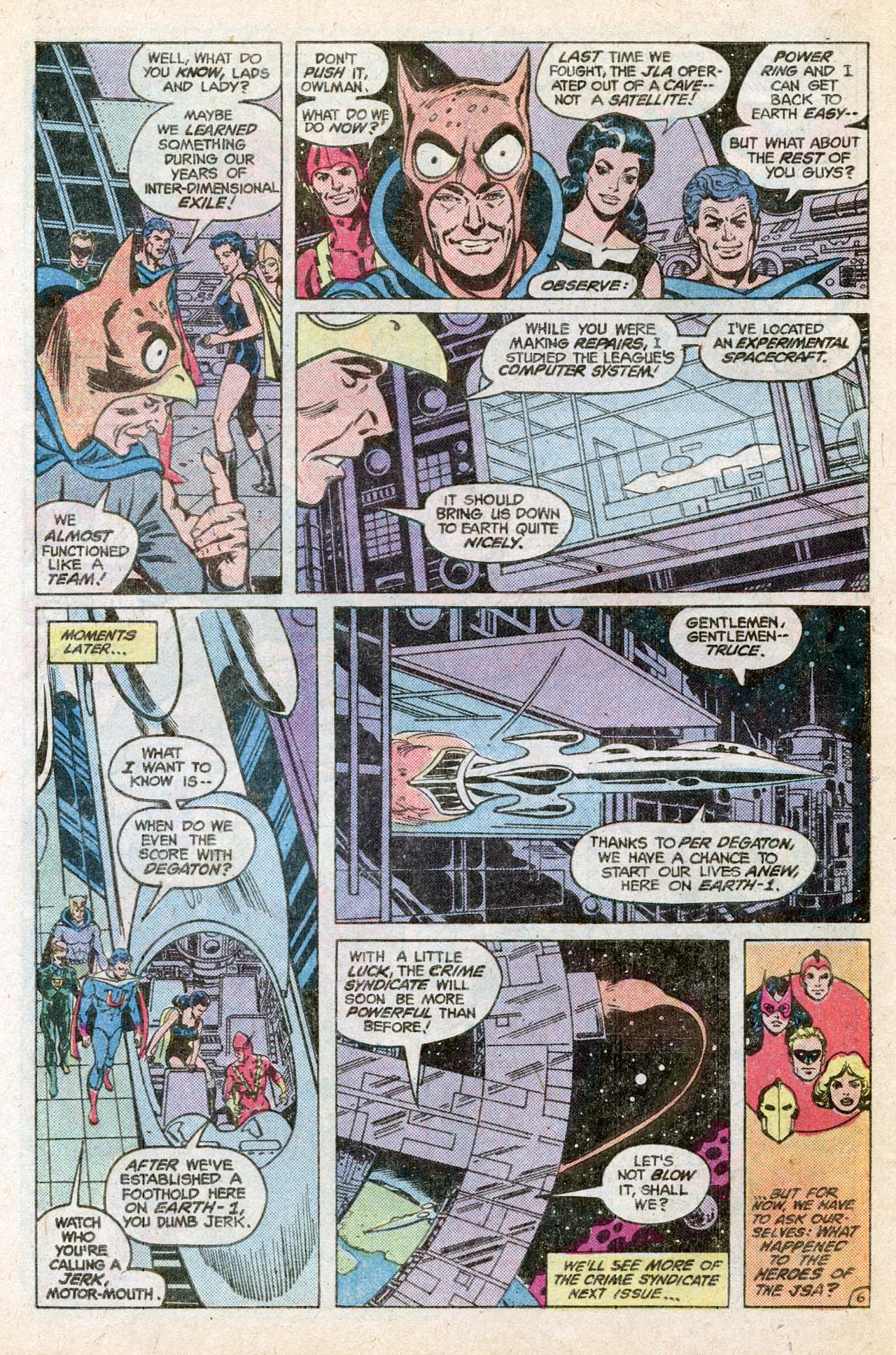 He got better duds from Frank Quitely, in Grant Morrison's Earth-2.  |
|
|
|
Post by codystarbuck on Mar 8, 2020 18:24:53 GMT -5
All-Star Squadron #14 Joe Kubert with his take on the guest-star head cover. Not quite the flair for it that Perez had, though his inner image is a great image, in it's staging. Kind of loses some power within the framing. Creative Team: Roy Thomas-writer, Adrian Gonzales-pencils, Jerry Ordway-inks, Ben Oda-letters, Carl Gafford-colors, Gerry Conway-plot consultant, Len Wein-editor Synopsis: The assembled might of the JSA and All-Star Squadron salute Per Degaton, ala gladiatorial combat....  Hope this was playing as they saluted... He gives the signal and the heroes open a keg of whoop-ass on each other, until Prof. Zee runs in and wakes them up, then they turn on old Per. Then he wakes up. It was all a dream; but, now he remembers what happened last time. So, he knows what he did wrong and heads over to the prof's lab and shoots him dead. He then sets the Wayback Machine ahead, to the year 1982; and, after a slight bump in the timestream, emerges in the future, only to find that the heroes he knows only exist in comic books! 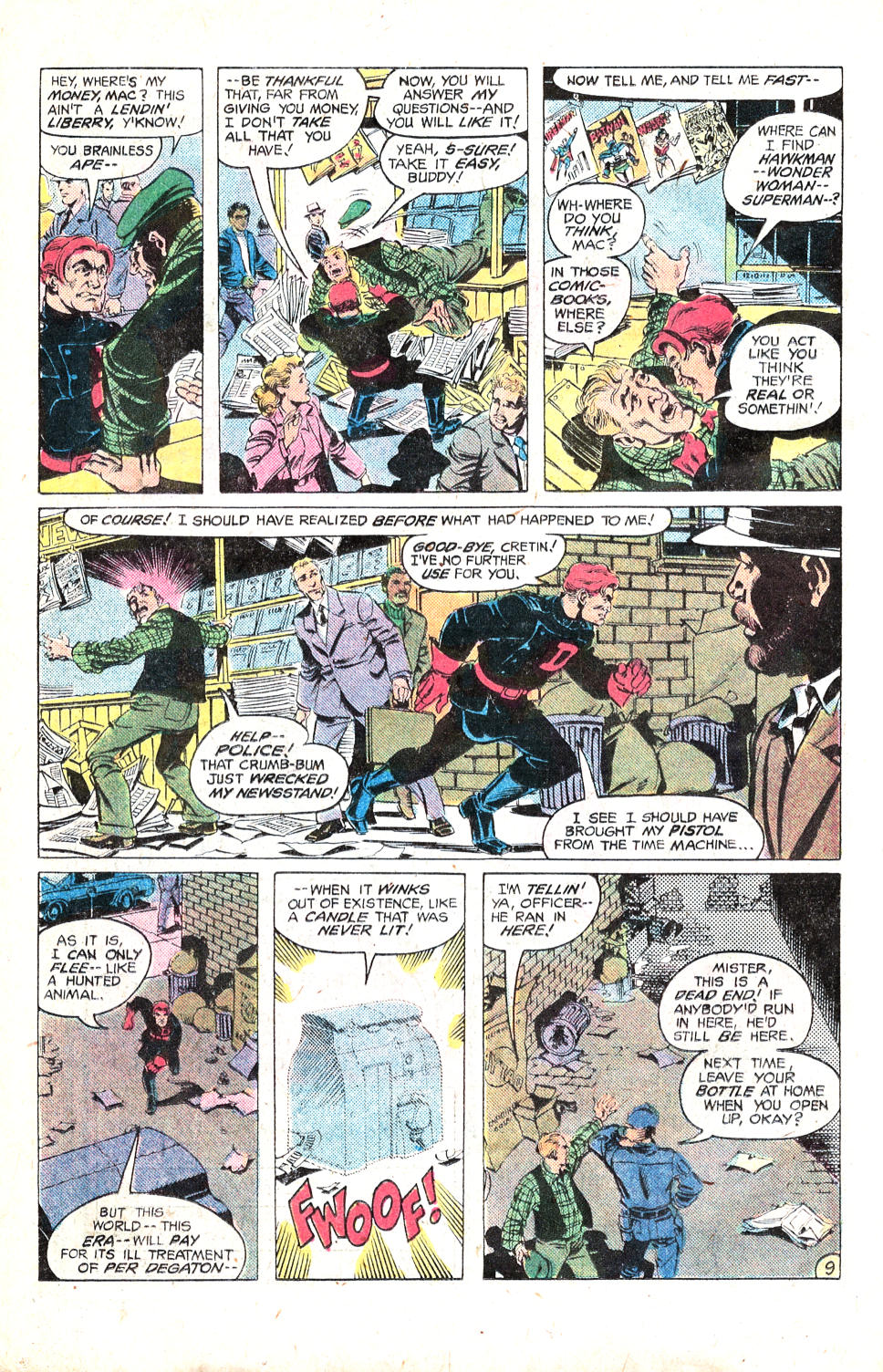 He jumps back in his machine and realizes he found a parallel world. he notes it for future conquest then heads off and ends up in a time storm, without a convenient time overpass under which to wait out the deluge. he ends up in limbo and meets up with the Crime Syndicate. They make threats and introductions, then Per recruits them to help. He heads to 1962 and messes with the Cuban Missile Crisis.....  They swipe the missiles and through things into chaos. The US doesn't believe the Russkie that the missiles are gone, the Russians can't look weak, and Castro is wetting himself. Degaton drags the missiles back to 1942 and the CSA try to double-cross him and he dumps them out on the time road, which is how they end up on Earth-1 (well, orbiting it, on the JLA satellite).  Meanwhile, on Earth-2, in 1942, the All-Stars run into some dweeb, named Nuclear, the Magnetic Marauder and have a scuffle. Robotman and Cdr Steel grab a cable, get pulled into Nuclear, dumping him (and them) over the side, forcing him to use his magnetic powers to pull on the building's steel structure to get away. The two metal heads lasso a flagpole (those are always conveniently place for any superhero need) and survive. They get down and the gang heads into the JSA Mansion and run smack into the JLA...  And we head back to JLA for the next chapter. Oh, you can enter the Swamp Thing movie contest, where you can get a trip to New York and a tour of the DC offices and meet the Swamp Thing creators. Somehow, I don't think they meant Len and Berni; though you might get to meet Len, by himself , and, maybe Marty Pasko and Tom Yeates. There was also an ad for Frogger, on the inside cover. Remember Frogger? You had to get a frog to cross a road, safely, then hop across logs to get across a river, without getting dumped or eaten by alligators, even though they don't really mess with frogs, as they can swim faster? Yes, our video games were just filled with excitement! You should see the wonder that was the Superman Atari game! Thoughts: More monkey-shines from old Per Degaton, whose schtick was getting old then. So, we learn what happened to Earth prime, as Per and the CSA basically trigger WW3, by escalating the Cuban Missile Crisis, way before the X-Men would nearly get us there. Nuclear made only one Golden Age appearance, in Wonder Woman #43, in 1950; so, this is early days for the guy. Roy's plot is structured based on a critical essay of Catch-22, which postulates the events of the novel are not told chronologically, except for Milo's shenanigans. Here, we kind of get the same thing, as Per Degaton's scheme unveils in a straight fashion, but everything else cuts back and forth in moments. Not sure who that makes Major Major... The end is the reverse side of JLA 207's meeting of the JLA and the All-Stars. One bit of irony was that Roy was not aware that gerry Conway had made Zatanna the JLA chairperson, and he had just made Liberty Belle the leader of the All-Stars; so, this ends up being a milestone in female superhero empowerment, by accident. Sisters are doing it for themselves! Historical Notes: The issues title, "The Mystery-Men of October," was inspired by the teleplay The Missiles of October, a dramatization of the White House decisions, during the Cuban Missile Crisis. It aired on December 18, 1974, and starred William Devane as John F Kennedy and Martin Sheen as Bobby Kennedy. I saw it when it was first broadcast and on a later repeat. Excellent drama, filled with great character actors, staged like an actual play, with limited sets.  To understand the Cuban Missile Crisis, we need to wind way back. For many decades, business interests in the US sought to make Cuba an American possession, both to exploit its proximity and its sugar cane crops and other agricultural opportunities. This was one of the underlying factors in the US going to war with Spain, after the explosion on the USS Maine, while in Havana harbor. Cuba was in open revolt against Spain and the US was protecting its interests. Hysterical news reports, generated by the papers of competitors William Randolph Hearst and Joseph Pulitzer helped push public opinion into declaring war on Spain, with ridiculous and unsubstantiated claims that they were behind the explosion. The US went to war with Spain, supporting revolutionaries in Cuba and the Philippines and eventually ended up with those territories and Guam. Cuba gained its independence, as promised (eventually); but, was economically and politically dominated by US business and political interests, for decades. This including the US backing of the dictator Fulgencio Batista, who was also sympathetic to organized crime interests in casinos and nightclubs, in Havana. Revolution broke out, led by Fidel Castro, his brother Raoul, and Ernesto "Che" Guevara. Eventually, the Marxist forces defeated the batista forces and set up a Communist government, with Castro as the head (until his death). This prompted plans by the CIA to train Cuban political exiles to launch a counter-invasion and overthrow the Communist government. The plan was formulated and continued under the Eisenhower Administration, but it was the new Kennedy Administration that was induced to launch the actual invasion, in 1961. The invasion was carried out by Cuban trainees and pilots, who flew surplus B-26 marauder bombers (which had proven an excellent profile for attack bombing, in WW2). However, set backs and threats from the USSR led to reduced US military support during the invasion phase. Aircraft from the USS Essex flew combat sorties, without nationality markings, hoping to suppress Cuban response, but without full scale attacks on Cuban forces. The invasion force floundered, due to a series of losses and foul ups (even the success of the Normandy invasion was heavily impaired by air drops that went awry and landings in incorrect spots) and Cuba was able to route the invaders, embarrassing the Kennedy Administration, which destroyed his trust of the CIA. Castro, fearing more such actions, got cozier with the USSR, who saw the failure as a sign of weakness in the US and made the bold move of placing ICBMs at launch sites within Cuba. These sites were detected by US aerial reconnaissance flights and confirmed by the insertion of Navy SEAL operators (in one of their earliest missions, as the newly designated SEAL special warfare unit). The US brought evidence of the Russian missiles to the UN and called for a resolution condemning the Soviet interference within the US sphere of influence and the US announced they would execute a naval blockade of Cuba, to prevent further supply of weapons and equipment to Cuba. The US and USSR were locked in a stand-off, with World War 3 imminent, when the Russians turned away from crossing the blockade and then agreed to remove the missile installations, eventually allowing the two countries to return to an equilibrium. 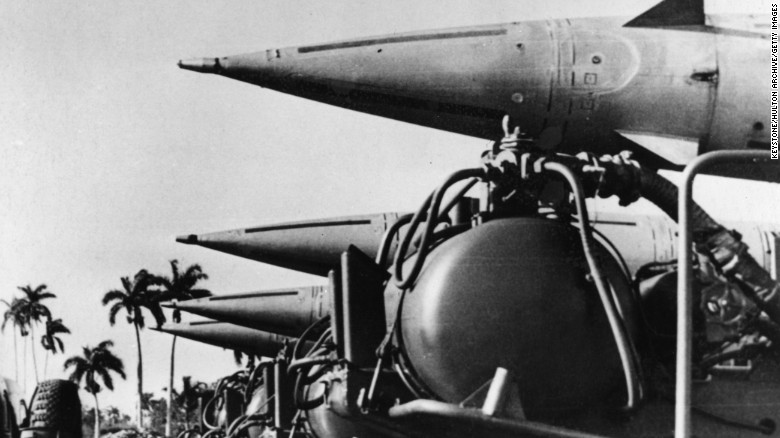 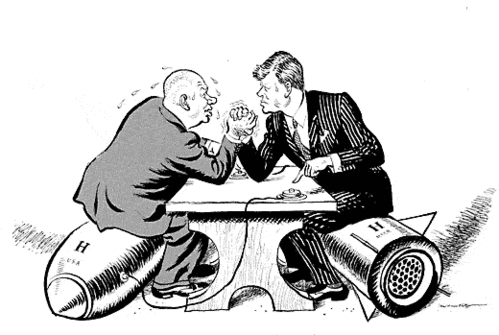
|
|


















 ). He mentions that no one is sure about Wonder Woman, who isn't a full fledged JSAer (she's a girl), though, little does he know, she is already in uniform.
). He mentions that no one is sure about Wonder Woman, who isn't a full fledged JSAer (she's a girl), though, little does he know, she is already in uniform.













